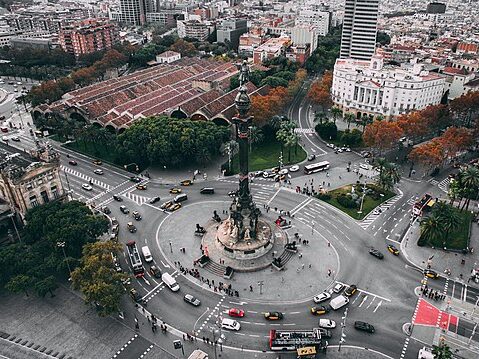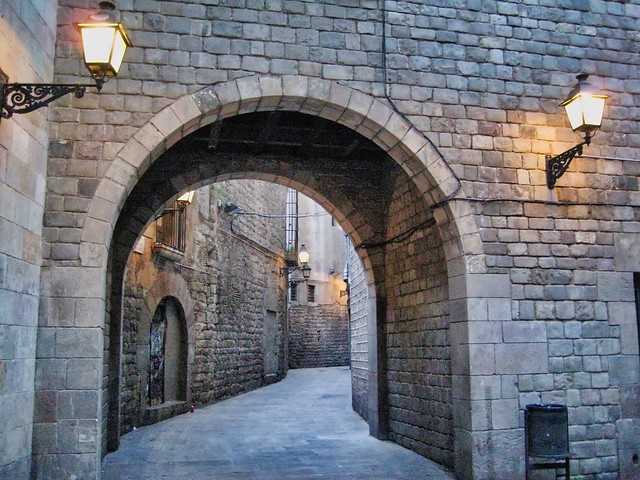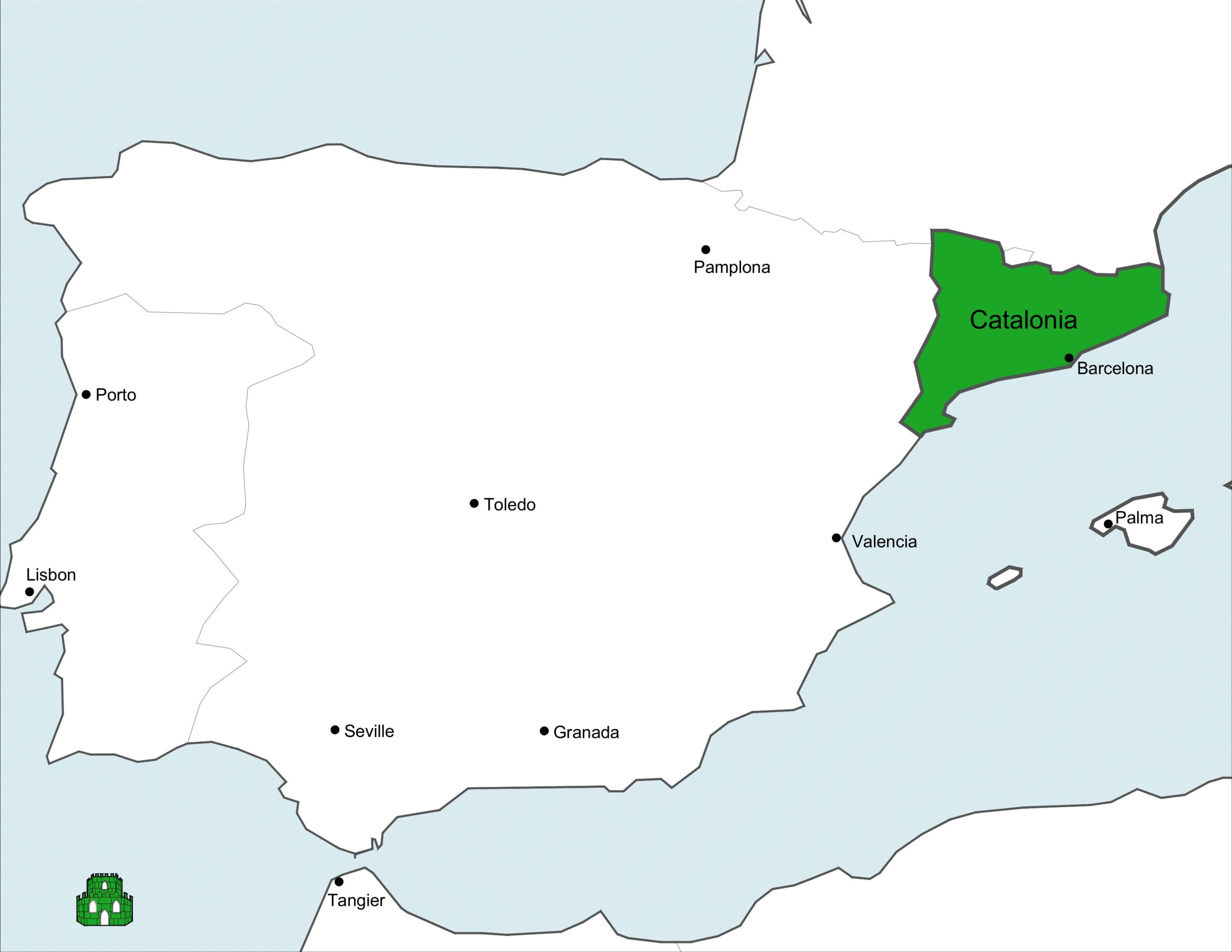Architecture of Barcelona, Catalonia, Spain
Barcelona is truly one of the world’s greatest cities for Architectural History. It contains glimpses of ancient Roman ruins, incredible Gothic Churches, and of course, the turn-of-the-century architecture of Antoni Gaudí and the Modernisme Movement. Barcelona is the capital of the region of Catalonia, and it sits on Spain’s vibrant Mediterranean Coastline. The city has become one of the world’s most popular destinations and millions of people visit for the food, the buildings, and the unique Catalonian Culture. This article will attempt to illustrate the greatest works of architecture in Barcelona, highlighting examples from all of the major ages in architectural history.

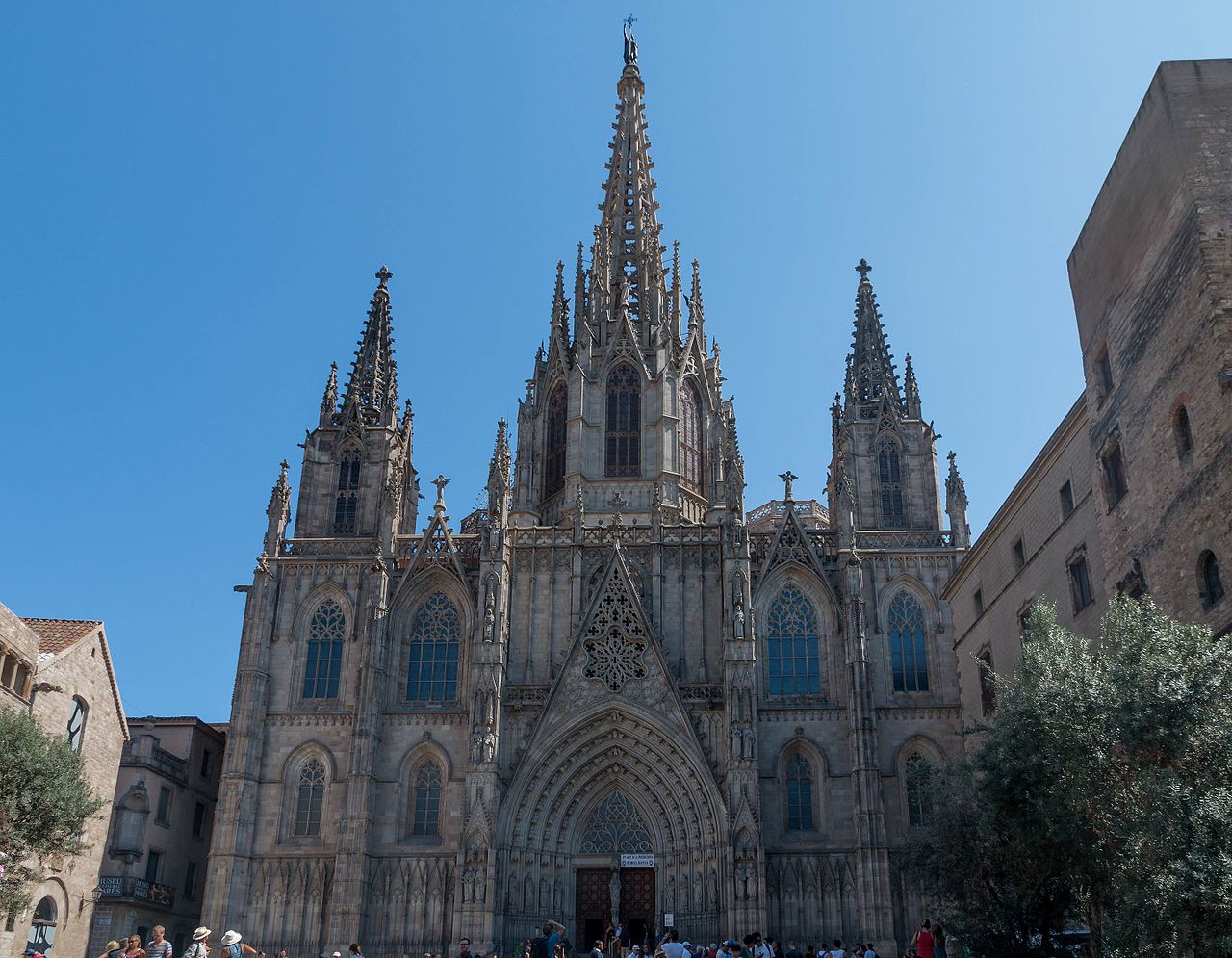
Map of Barcelona

Map of Barcelona highlighting some of the city’s main attractions.
1. La Rambla
2. Sagrada Família
3. Plaza Catalunya
4. Barcelona Cathedral
Table of Contents
History of Barcelona
Unifying Elements in Barcelona Architecture
Layers of History

Barcelona is an ancient city with a very dynamic history. Its Gothic Quarter contains architecture from multiple different ages. The image above shows some remnants of the city’s ancient Roman Walls, which are located right next to Barcelona Cathedral. This layering of different architectural styles is prevalent throughout all of Barcelona. The city is filled with countless examples of buildings that have been altered and expanded throughout many different architectural ages.
Color

Barcelona is a very colorful city. Buildings, particularly from the Modernisme Movement, contain a variety of bright and vibrant colors. Materials like stained glass, decorated tilework, and stucco are all utilized throughout the city, The image above shows the interior of the Sagrada Família. Here the immense stained glass windows flood the space with multi-colored beams of light.
Connection with Nature

Another element that repeats throughout the Architecture of Barcelona is a connection with nature. The city has a large assortment of parks and gardens, and many of its streets and plazas are lined with trees and other plants. The use of elements from nature is also an important component of the Modernisme Style. The image above shows some beautiful gardens within one of Barcelona’s largest green spaces: the Ciutadella Park. Here trees, plants, and water are all interconnected in one cohesive design.
Craftsmanship & Details
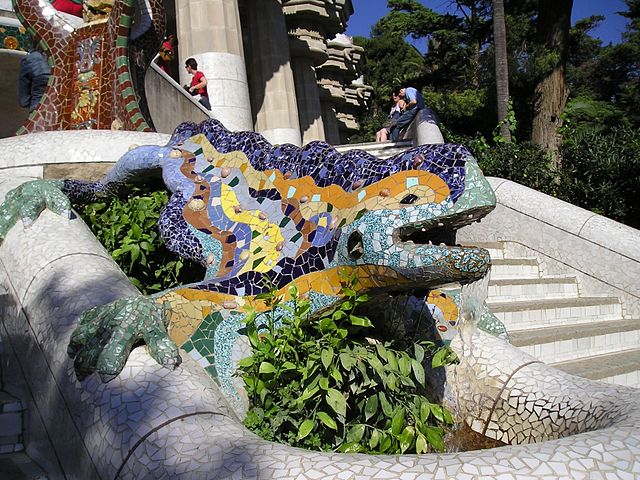
The Arts & Crafts Movement was another key component in the evolution of Barcelona. Many works of Modernisme Architecture contain lots of hand-crafted details, particularly in the works of Antoni Gaudí. The image above shows an intricate mosaic in the shape of a lizard outside Park Güell. Craftsmanship and intricate details are not limited to the Modernisme Style, however, and many of Barcelona’s Gothic and Revival buildings also contain examples of these techniques.
Catalan Gothic

“Catalan Gothic” is a term used to describe Gothic Architecture in the Region of Catalonia. Examples of Catalan Gothic can be found in other cities like Girona and Palma de Mallorca. There are several examples of this style within Barcelona’s Gothic Quarter. The image above shows the Chapel of Santa Àgata. This church has a tower that resembles many others scattered throughout Barcelona’s historic core.
Barcelona’s Eixample District
During the 19th century, Barcelona was experiencing a boom in population and economic activity. The city then needed to expand past the original historic center. In 1859 an urban planner by the name of Ildefons Cerdà
drew up a plan for an expansion of the city. This area, known as the Eixample district, is now regarded as one of the world’s most successful examples of urban planning.

Diagram of Barcelona’s Eixample District.
The plan above shows the gridded system of streets and city blocks. Most blocks are perfectly square with the streets spaced evenly, except for a few lengthy avenues connecting major destinations across the city. Each building block has chamfered corners, which help reduce congestion and bring more light into the streets. This human-focused approach makes people feel welcome and comfortable and is a large part of why Barcelona is such a warm and inviting city.
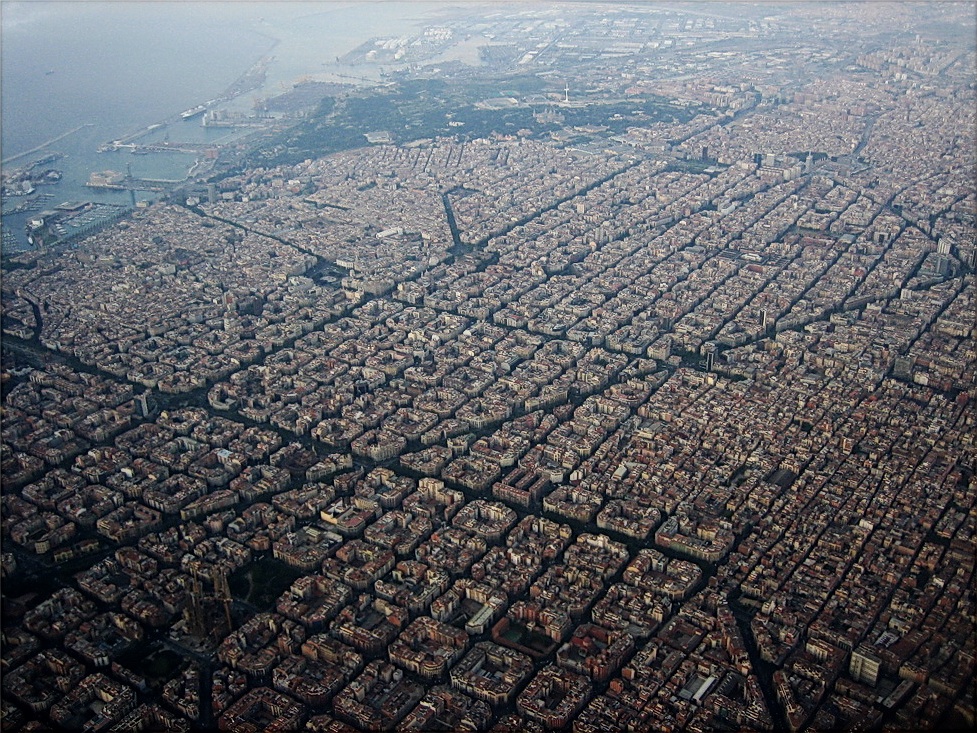
Ancient Roman Architecture in Barcelona
Barcelona is a city with ancient roots. It was a major port within the Roman Empire and a huge producer of Olive Oil and other goods. Modern Barcelona contains only a few traces of Roman Architecture, but you can still get a feel for the ancient history of the city thanks to these sporadic examples.
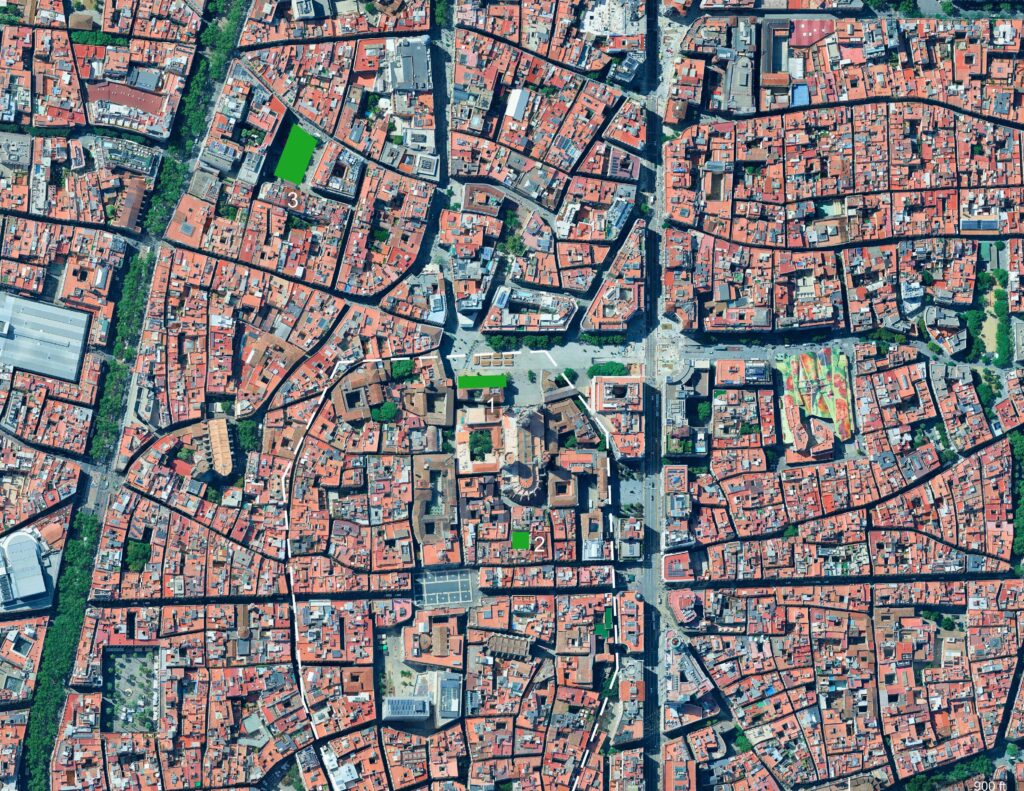
Map of Barcelona highlighting the most notable works of Ancient Roman Architecture within the city.
The borders of the Roman city of Barcino are shown with a dashed line.
1. Ruins of the Roman Walls

Barcelona was once enclosed by a fortified wall dating to the Roman period. Most Roman cities were enclosed by walls which typically featured strategically placed guard towers. In the image above you can see the remnants of the ancient wall, which has since been incorporated into more modern buildings. Eventually, Barcelona outgrew its Roman Walls and a ring of Medieval Walls was constructed to enclose the area now known as the Gothic Quarter.
2. Ruins of the Temple of Augustus

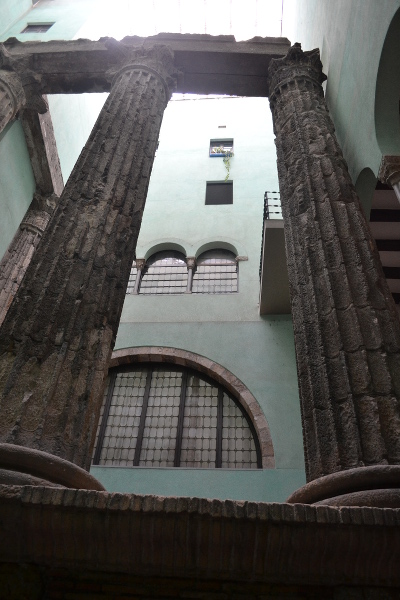
The Temple of Augustus Is one of the most notable works of Roman Architecture in Barcelona. It’s located in the small courtyard of an office building in the Gothic Quarter. It was once a mighty structure, and today only a few of its original Corinthian Columns are still standing. The rest of the building was looted and repurposed into other structures throughout Barcelona – a common practice in former Roman cities.
3. Via Sepulcral Romana
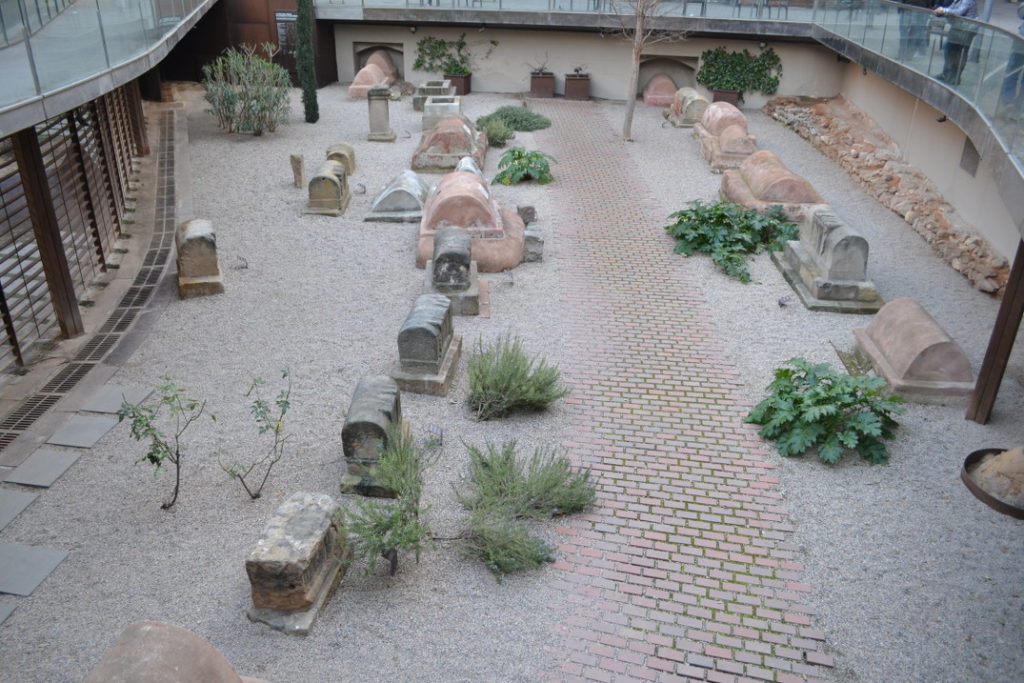
In addition to the two structures above, Barcelona is filled with many other ancient Roman artifacts and monuments. Within the Via Sepulchral Romana, you can see several Roman sarcophagi, each carved from solid stone. Many wealthy Romans chose to be buried in tombs like this, and antiquities museums throughout the world contain similar artifacts.
Gothic Architecture in Barcelona
The Gothic Period was in many ways a Golden Age for Barcelona. At this point in time, Catalonia was both powerful and influential, with its own governing body known as the Consell de Cent. Catalonia became part of the Kingdom of Aragon following a royal marriage in 1137. From the 12th century until the early 15th century, the city prospered and benefited from Aragonese expansion throughout Spain and the Mediterranean. There are several impressive examples of Gothic Architecture in Barcelona from this age, and most are located in the city’s aptly named “Gothic Quarter.”

Map of Barcelona highlighting the most notable works of Gothic Architecture within the city.
The white line represents the medieval fortifications of Barcelona.
1. Barcelona Cathedral
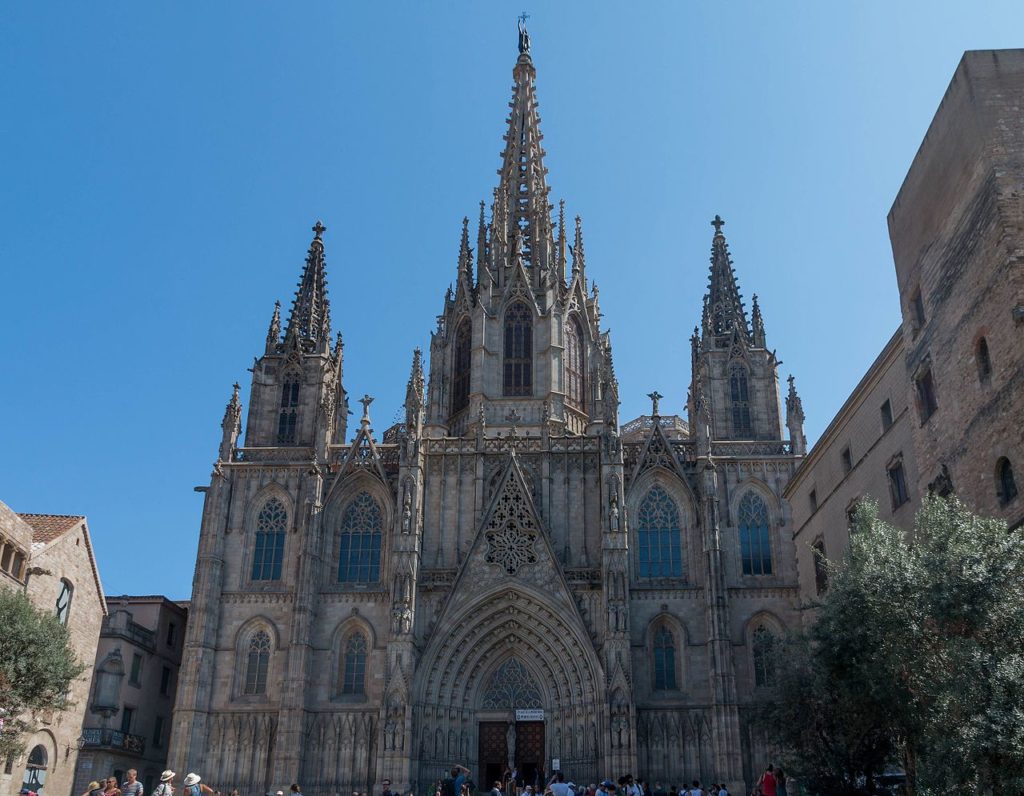
Barcelona Cathedral is one of the most notable works of Gothic Architecture in all of Spain. It was constructed in several phases beginning in the year 1298. The church features all of the typical characteristics of the Gothic Style, including pointed arches, pinnacles, and Gothic Tracery. The cathedral’s cloisters were completed in the 1400s, and the main facade was unfinished until the Revival Period of the late 19th century. Today the church’s main facade overlooks the Placa Nova, one of many lively squares in Barcelona’s historic center.

The interior of Barcelona Cathedral resembles many other examples of Catalan Gothic Architecture. It is stark and void of lots of the ornamentation found in other types of religious buildings. The church has a wide variety of Stained Glass Windows, which are a marvel of Medieval craftsmanship. Today Barcelona Cathedral remains the city’s principal church, however, it has been surpassed as the city’s largest church by The Sagrada Família.
2. Santa Maria del Mar

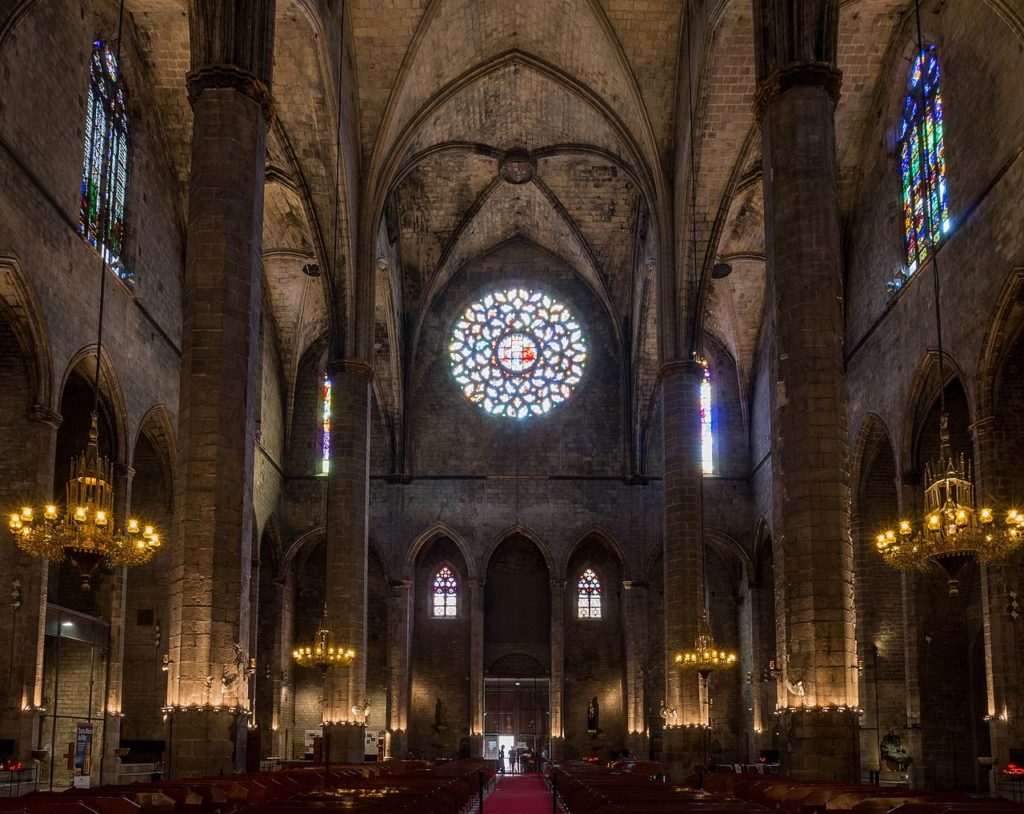
The Church of Santa Maria Del Mar is another impressive example of Gothic Architecture in Barcelona. The name loosely translates in English to “St. Marie’s by the Sea” which is a reference to the church’s location, not far from the Mediterranean. Santa Maria del Mar was constructed in the mid-1300s, at a time when Barcelona was reaching its peak as a mercantile power within the Kingdom of Aragon.
3. Santa Maria del Pi
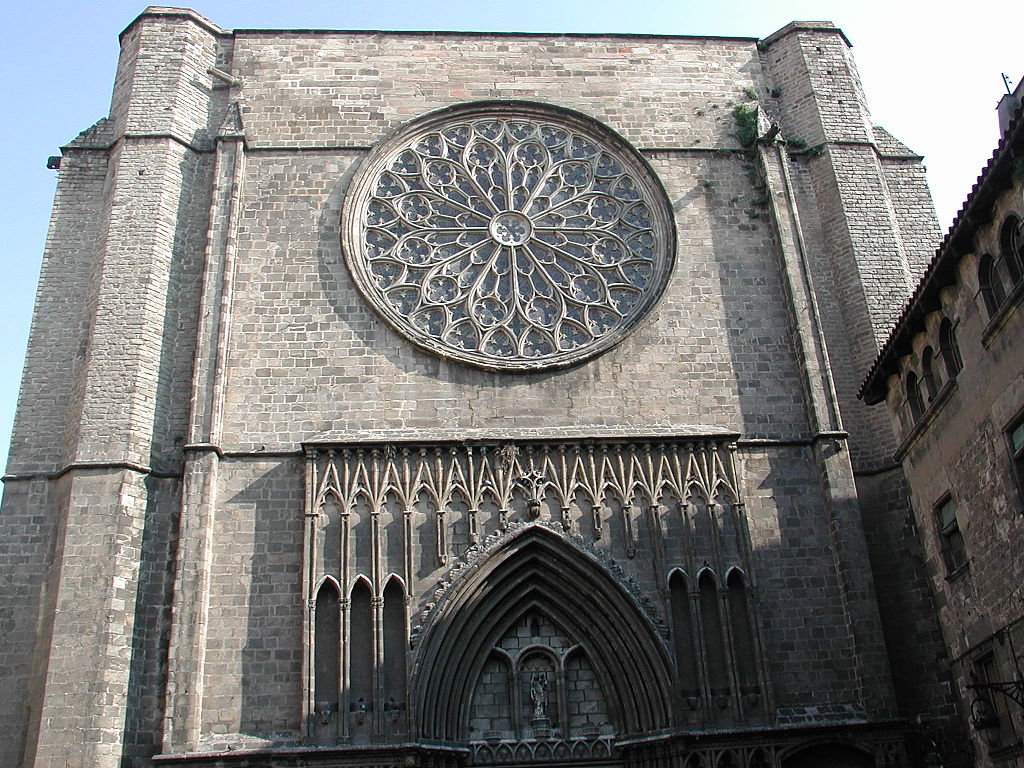

The Basilica of Santa Maria del Pi is located in the Gothic Quarter of Barcelona. Construction began in the 1300s, and it was one of several Gothic-style churches in the area. Santa Maria del Pi is located just off of La Rambla, and it overlooks a small square known as the Plaça del Pi. One of the church’s most striking features is the large Rose Window located on its main facade. Rose Windows were used throughout many examples of Gothic Architecture, and they are always composed of complex stonework and intricate stained glass.
4. Chapel of Santa Àgata

Located right next to Barcelona Cathedral, the Chapel of Santa Àgata is another impressive work of Gothic Architecture in the city, The chapel dates from the peak of the Gothic Age in the early 14th century, when massive cathedrals were being constructed throughout Western Europe. Like many buildings from the Age of Catalan Gothic, the chapel is very stern and austere. It contains a lot of bold simplified geometries and is made almost entirely from one type of masonry.
5. Barcelona Royal Shipyard

Dating from the 13th century, the Barcelona Royal Shipyard is a large building that today houses Barcelona’s Maritime Museum. It is a massive building, measuring over 515′ x 280′ (156 m x 85 m), and it’s composed of a series of lengthy arched vaults. These spaces were ideal for shipbuilding, and they were able to create enough ships to fuel Catalonia’s economic growth during the Middle Ages. Adjacent to the Barcelona Royal Shipyard you can also see the last vestiges of the Medieval Walls that once enclosed the city center.
6. Saló de Cent

The Saló de Cent is a historic building that dates from the late 14th century. It was built as the chambers for the Consell de Cent or The Council of One Hundred. The council was composed of 100 nobles and was dedicated to governing Barcelona and Catalonia. The Consell de Cent helped to transform Barcelona into a leading city during the Middle Ages. Eventually, the council and its chambers were reintegrated into the modern government of Barcelona, and the Saló de Cent is now a part of Barcelona City Hall.
7. Placa del Rei

The Placa del Rei is a small square located in the heart of the Gothic Quarter. It is nestled in between other notable sites like Barcelona Cathedral and the Chapel of Santa Àgata. The image above shows the main facade of the Palau Reial Major, which overlooks the square. This palace once belonged to the rulers of Barcelona, and it was constructed in several phases beginning in the mid-14th century. This Placa del Rei is one of many amazing squares within central Barcelona, and its quiet ambiance provides a nice break from the busy surrounding area.
8. Santa Anna Church


Hidden in an area surrounded by modern-day buildings, the Santa Anna Church is a little-known work of Gothic Architecture located in Barcelona. The original portion of the church dates to the Romanesque Age, and it was constructed during the late 1100s. The church also contains a very well-preserved cloister, designed in the Catalan Gothic Style. The cloister was completed after the rest of the church and is filled with many of the same palm trees and other plants found throughout the rest of Barcelona.
9. Sant Felip Neri Square
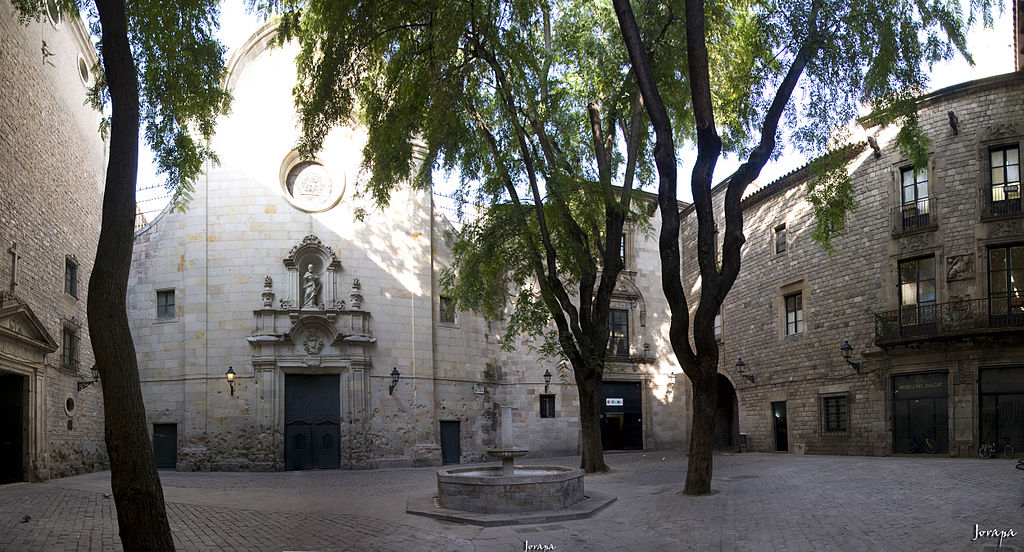
The Plaça de Sant Felip Neri is a small square located in Barcelona’s historic center. It’s lined with several different buildings from the Middle Ages. During the Spanish Civil War, a bomb was dropped directly into the square. The explosion that followed left damage in the surrounding buildings and holes and divots from the shrapnel can be seen in the lower portions of the Church of Saint Philip Neri.
10. Old Hospital de la Santa Creu

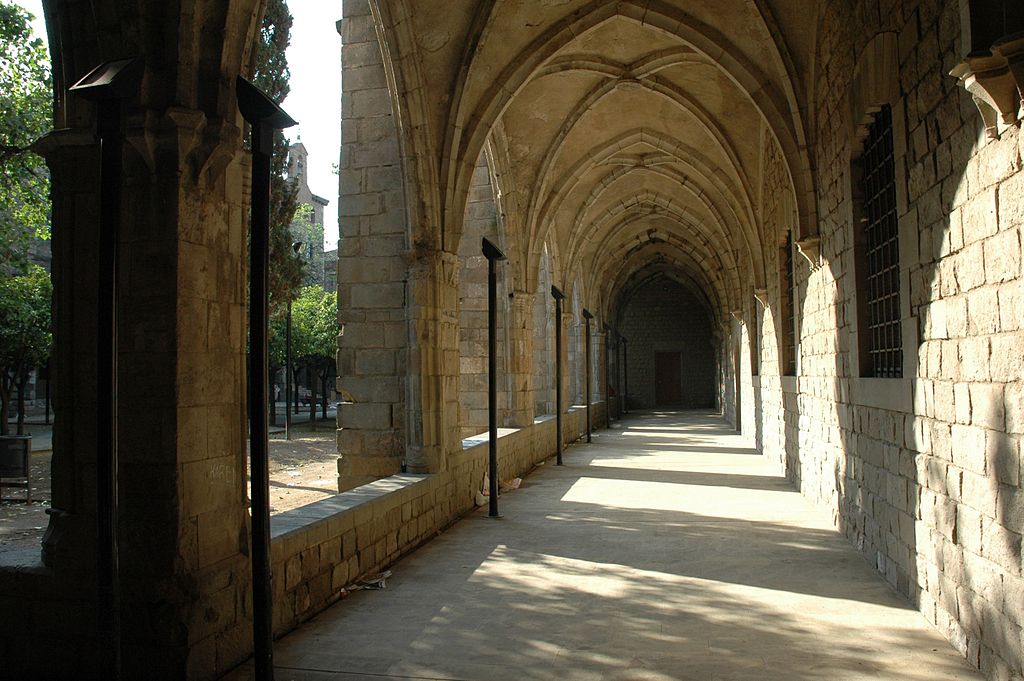
The Old Hospital de la Santa Creu is a building in central Barcelona, located just off of La Rambla. It was originally constructed in the Gothic Age, and the oldest portions of the building feature pointed arches and large arched vaults. The building also contains several additions from the Renaissance Age, from an expansion that occurred in the 16oos.
11. Sant Pau del Camp


With a foundation dating all the way back to 977, Sant Pau del Camp is one of the oldest churches in Barcelona. It’s one of the city’s greatest works of Romanesque Architecture, and it embodies many of the typical elements of the Romanesque Style. It has a simple boxy form, and it contains mostly round arches. The church does have a few Gothic touches, as it was modified periodically throughout the Middle Ages. You can get a great view of the church’s stark interior inside this Photo Sphere.
12. Llotja de Mar
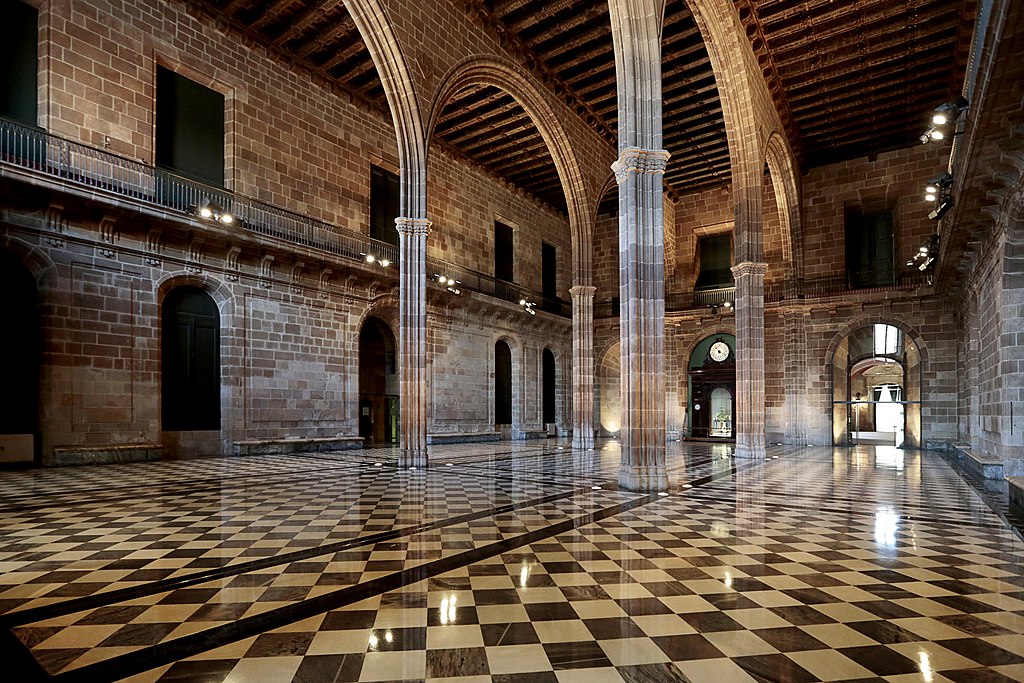
The Llotja de Mar was a mercantile building constructed during the height of the Gothic Age. There are similar Llotjas throughout the region, in cities like Valencia and Palma de Mallorca. All of these various structures were designed to be large trading halls where merchants would buy and sell various goods. Barcelona was a trading hub in the Middle Ages, and lots of luxurious items like silks, textiles, jewels, and precious metals were traded right here. Eventually, the main halls of the Gothic Llotja were completely enclosed within a Neoclassical Building constructed in the 19th century.
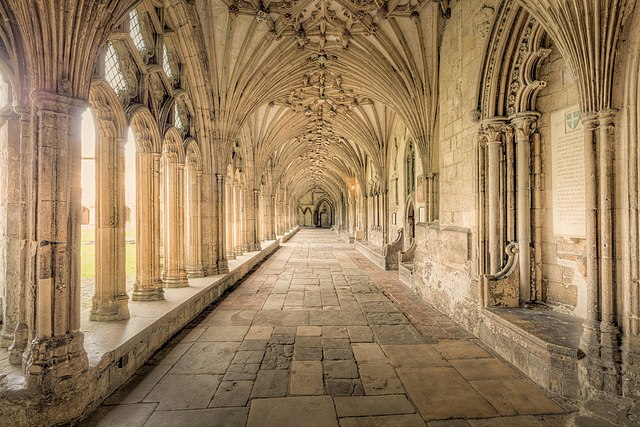
Gothic was the dominant architectural style in Europe during the early Middle Ages. Check out our article on the Top 25 Examples of Gothic Architecture to learn more!
Renaissance & Baroque Architecture in Barcelona
The Spanish Kingdoms of Aragon and Castile merged through a Royal Marriage in 1469, at which point in time, Catalonia lost much of its political prestige. The Catalonians pushed back on rule from Madrid and fought several uprisings throughout the 17th & 18th centuries. In 1714, During the War of Spanish Succession, Barcelona was besieged and fell after holding out for over a year. The victorious Spanish rulers then built the infamous Ciudatella fortress in an attempt to punish the local people.
The turmoil of this era led to relative stagnation for Barcelona. The city does not have that much Renaissance & Baroque architecture, especially when compared to other Spanish cities like Seville. Regardless, there are still some impressive examples of these building styles scattered throughout various neighborhoods in Barcelona, and they blend with the city’s other Gothic and Revival monuments.

Map of Barcelona highlighting the most notable works of Renaissance and Baroque Architecture within the city.
The white lines represent the Baroque-Age fortifications that once surrounded Barcelona.
1. Palau de la Generalitat de Catalunya

The Palau de la Generalitat de Catalunya is Barcelona’s most impressive example of Renaissance Architecture. The building was constructed in the late 1500s to house several components of the Government of Catalonia – a purpose that it still serves today. The facade of the building contains all of the typical elements found in the Renaissance Style. There is a strong emphasis on symmetry, proportion, and balance, with the implementation of Classical details like pediments and balustrades,
2. Palace of the Parliament of Catalonia
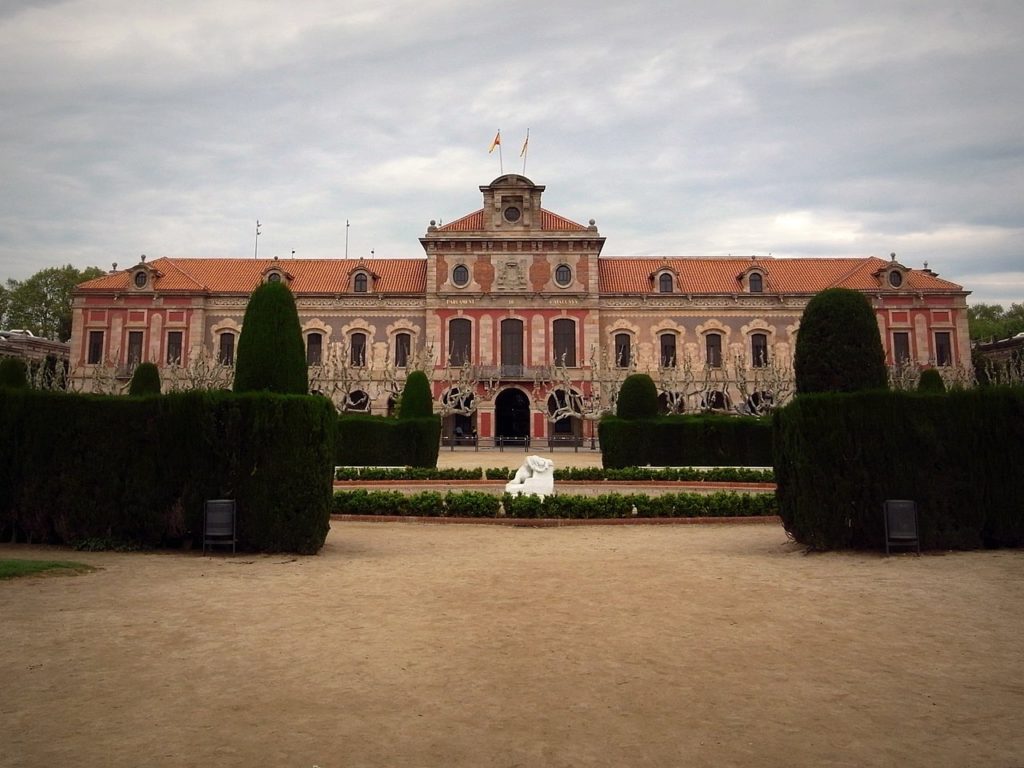
Located in the heart of the Ciutadella Park, the Palace of the Parliament of Catalonia is a large Baroque Building that dates from the early 18th century. It was originally built as an arsenal to store weapons and munitions inside the Ciutadella Fortress. The building features many of the typical elements found in the Baroque Style, including a brightly colored facade, complete with elliptical windows and intricate stone details. The Parliament of Catalonia is responsible for governing the Autonomous Region of Catalonia – one of the seventeen autonomous communities that make up modern-day Spain.
3. Montjuïc Fortress

The Fortress of Montjuïc is located on a hill overlooking the Southwest corner of Barcelona’s city center. Fortifications have existed here for nearly 1000 years, but most of the structure we see today dates from when Montjuïc Fortress was overhauled in the late 18th century. Designed in the typical Star Fort format, Montjuïc Fortress has a protected central space surrounded by a series of angular earthen-packed walls. This design was extremely effective and helped protect the fort from cannon fire while also providing positions to attack the enemy from their flanks.
4. Basilica of Our Lady of Mercy

The Basilica of Our Lady of Mercy is located in the Gothic Quarter, just a few steps off of La Rambla. It’s one of the few Baroque Churches in Barcelona, and it was completed in the late 1700s. The church was constructed atop the foundation of a much older building dating from the Gothic Age in the 13th century. The main facade of the basilica has a large elliptical window, which is a detail found throughout many works of Baroque Architecture. This contrasts the typically circular Rose Windows, found in many of Barcelona’s Gothic Churches.
5. Palau Dalmases
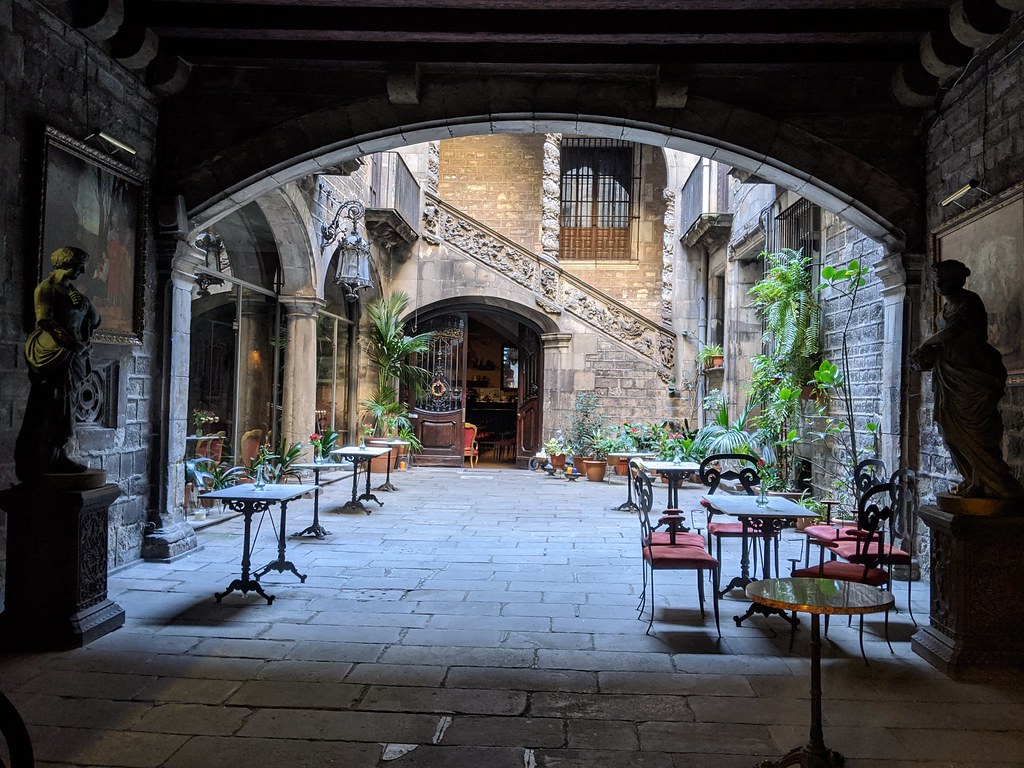
Palau Dalmases is a former residence located in Barcelona’s Gothic Quarter. It originated as a series of houses dating from the Gothic Age. The buildings were then purchased and reformed by a wealthy Catalonian family in the late 17th century. The resulting home is an interesting blend of various architectural styles, including Baroque, Renaissance, and Gothic. The image above shows the building’s central courtyard, which contains an elaborate staircase complete with detailed stonework and spiralized columns.
6. Old Hospital de la Santa Creu (cloister)

The Old Hospital de la Santa Creu is a notable Gothic building in Barcelona dating from the 13th century, It was greatly expanded during the 17th century at a time when Renaissance Architecture was reaching its peak of popularity within Spain. The image above shows the main cloister of the hospital, which is enclosed by two wings that were additions to the building. This cloister embodies many of the ideals of the Renaissance, including symmetry, repetition, proportion, and balance. Today the Old Hospital de la Santa Creu is a protected landmark that houses the National Library of Catalonia.

Check out our article on the Architecture of Florence to learn more about the birth of the Renaissance in Italy.
Revival & Beaux Arts Architecture in Barcelona
During the 19th century, Barcelona became an important economic hub within Spain. The Industrial Revolution brought manufacturing jobs, and Barcelona’s population grew dramatically. The city expanded outside its Medieval Borders in a large planned development project known as the Eixample. The Eixample district is famous for its gridded street plan, with building plots that have chamfered corners.
Barcelona also hosted two different World’s Fairs during this period. The first was the 1888 Barcelona Universal Exposition which took place in the brand-new Ciutadella Park. The park was created in the spot where the hated Ciutadella Fortress once stood.
The city then hosted the 1929 Barcelona International Exposition which led to the creation of many impressive buildings such as the Palau National de Muntjuic. Today Barcelona is filled with many impressive examples of Revival & Beaux Arts Architecture from the booming times of the late 19th & early 20th centuries.

Map of Barcelona highlighting the most notable works of Revival & Beaux Arts Architecture within the city.
(#4 on the list is not depicted)
1. Palau Nacional de Montjuïc
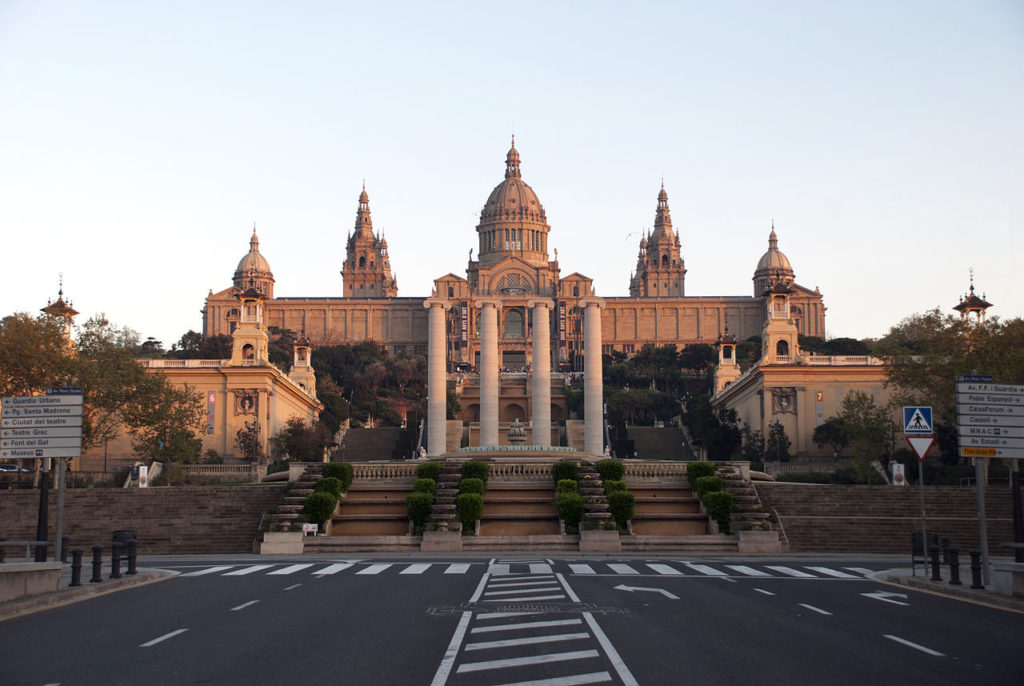
The Palau National is located at the base of Montjuïc Hill and is Barcelona’s most impressive work of Spanish Renaissance Revival Architecture. The Palau National was the focal point of the Barcelona International Exposition of 1929. The building features a long axial entrance lined with fountains, plazas, and walkways. There are also four impressive Ionic-style columns that align with the Palau National’s main entrance. The overall design features many of the ideals found in the Revivalist Movement in Architecture – when most architects focused on recreating buildings from the past.
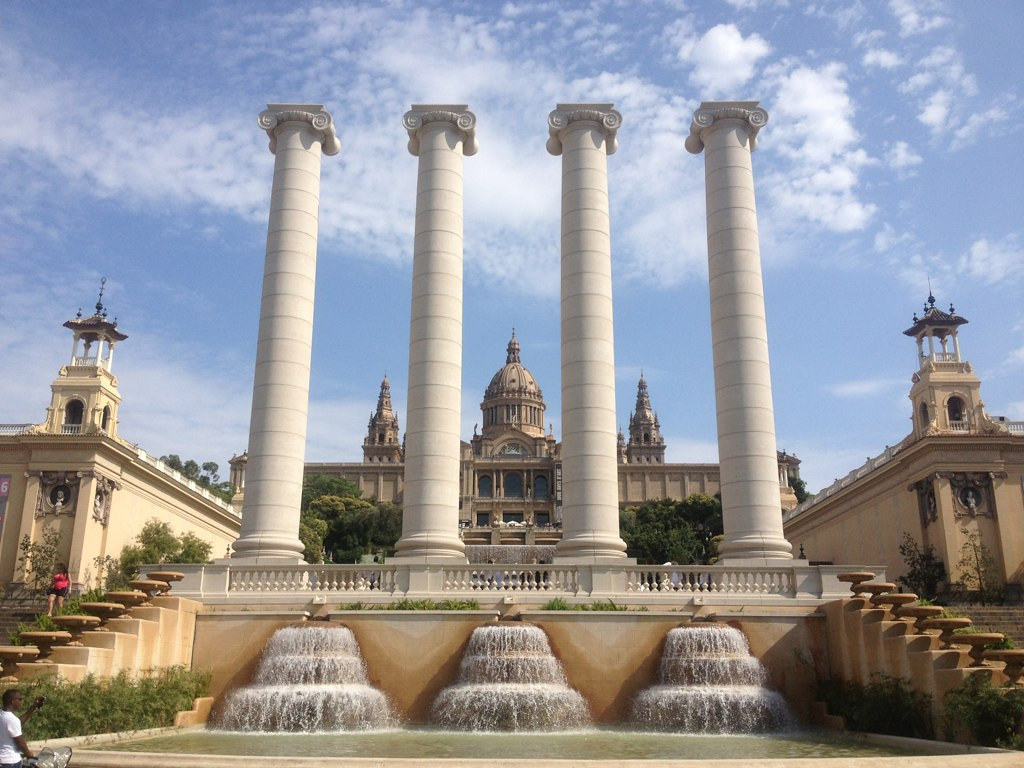
Today the Palau Nacional de Montjuïc houses the National Art Museum of Catalonia. The museum is one of Spain’s most renowned art institutions, and it contains pieces from popular artists such as El Greco, Tiepolo, and Canaletto. It also houses a large collection of Romanesque and Gothic Art from Catalonia’s Medieval Period. The building was renovated in the early 2000s, and today it houses more than 5,000 individual works of art.
2. Ciutadella Park

Ciutadella Park is a large public green space located just to the east of Barcelona’s historic center. It was formerly the site of the infamous Ciutadella Fortress, a hated landmark by the local population. The original fortress was built after the War of Spanish Succession to intimidate Barcelona’s population and prevent future revolts. The fortress stood from 1714 until the 1860s when it was demolished. Eventually, city officials decided to convert the area into a new park that would serve as the main grounds for the 1888 Barcelona Universal Exposition.
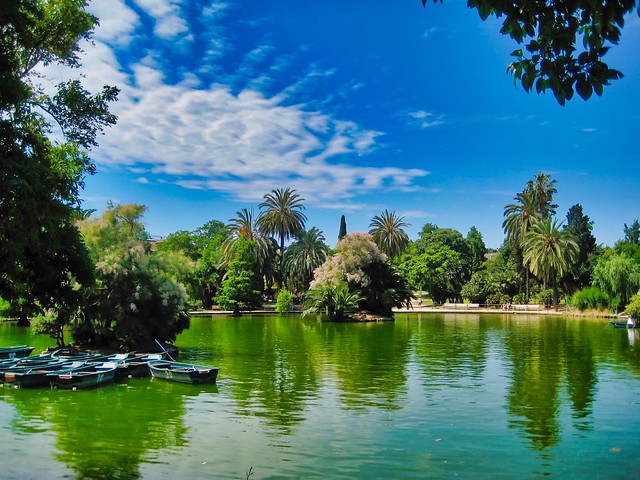

Barcelona is a pretty dense city, particularly in the Gothic Quarter, and the park gives locals a place to escape the business of the city streets. Ciutadella Park contains a manmade lake, and an assortment of gardens, grassy areas, and tree-lined pathways. The park’s architectural highlights include the Cascade Monument, The Castle of the Three Dragons, and the Plaça de Joan Fiveller.
3. Plaça Reial

Plaça Reial is one of the larger squares in Barcelona’s historic core. The square is centrally located in the Gothic Quarter, just steps off La Rambla. The square and its facades date from the late 19th century, and they were designed in the Revival Style, with elements from Renaissance Revival and Neoclassical Architecture. Plaça Reial is known for its nightlife, and it is home to many popular bars, clubs, and restaurants. The square is also filled with several impressive lamposts that were designed by renowned Catalonian Architect, Antoni Gaudí.
4. Temple of the Sacred Heart of Jesus
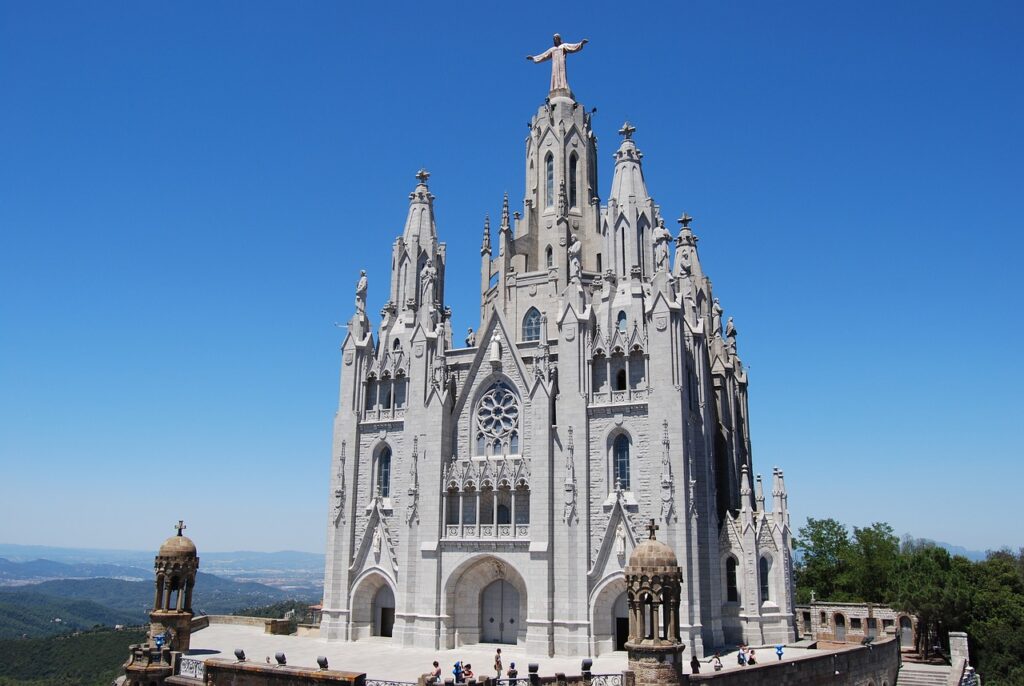
The Temple of the Sacred Heart of Jesus is an impressive work of Gothic Revival Architecture in Barcelona. It’s located about 4.5 miles (7 km) away from Barcelona’s city center, on top of Mount Tibidabo. Construction began on the church in 1902, but it wasn’t completed until 1961, Many people visit the building for its impressive position, overlooking all of Barcelona and the Mediterranean Sea. The church combines typical elements in Gothic Architecture, including pointed arches, flying buttresses, spires, and stained glass,
5. Arc de Triomf

The Arc de Triomf is a monumental Triumphal Arch located in Barcelona. It was built as part of the grounds for the 1888 Barcelona Universal Exposition. It marks the beginning of the Passeig de Lluís Companys which leads to the entrance of Ciutadella Park. The form of the arch is reminiscent of the Triumphal Arches of the Ancient Romans, however, Barcelona’s Arc de Triomf also contains strong influences from Mudejar and Catalonian Architecture.
6. Plaza Catalunya

Because construction of the Eixample District began in the late 19th century, many of the buildings within were designed in various forms of Revival Architecture. Plaza Catalunya is home to many of Barcelona’s most impressive Revival Style buildings. Although it has some more modern structures, there are still some Neoclassical and Renaissance Revival facades fronting the square.
7. Barcelona Customs Building

The Barcelona Customs Building is located at the endpoint of La Rambla, in the heart of Barcelona’s Port Vell. The building was designed in the Beaux Arts Style and was completed in 1902. The front facade faces the Royal Shipyard, and it combines many of the important elements of Beaux Arts Architecture. There is a strong influence from Classical & Baroque Architecture, but there are added sculptures and details that break away from more traditional designs.
8. Columbus Monument

The Columbus Monument is a Triumphal Column located at the termination point of La Rambla. The Column was erected in preparation for the 1888 Barcelona Universal Exposition, and it commemorates one of Spain’s most important historical figures: Christopher Columbus. Although today a controversial figure, Columbus helped create the Spanish Colonial Empire which helped Spain reach its territorial & cultural peak. The Columbus Monument is a great example of the thinking of the Neoclassical Period when builders borrowed heavily from the monuments of the Ancient Romans. The Columbus Monument greatly resembles the Victory Columns constructed throughout the Roman Empire.
9. Palau de Justícia

The Palau de Justica is a courthouse in central Barcelona that was constructed a year before the 1888 Barcelona Universal Exposition. It is located along a promenade that connects Ciutadella Park and the rest of the Eixample Neighborhood. The building was designed in the Beaux Arts Style, and it also contains many elements that were precursors to the Modernisme Movement. The Palau de Justica is known for its ornate stonework & statues, and it still houses the High Court of Justice of Catalonia.
10. El Born Market Hall
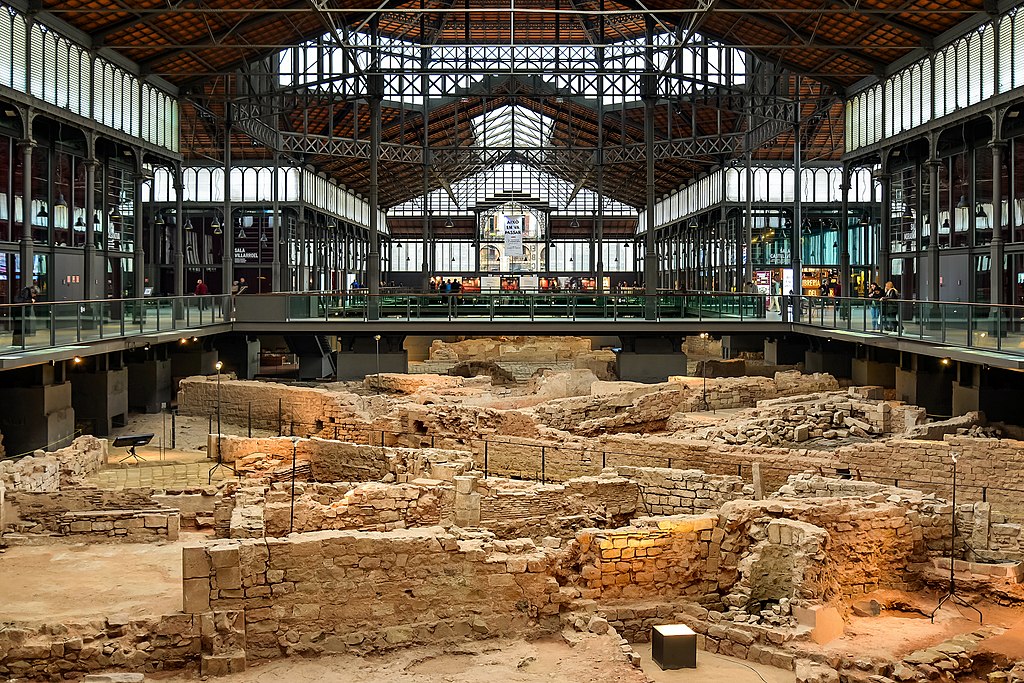
The El Born Market Hall is a very interesting building with a unique history. It was originally constructed in the late 19th century as a covered market for local vendors to sell food, produce, and other staples. It served this purpose up until the 1970s when the market closed. Then, in a surprise twist, the empty building was converted into a museum and cultural center. The El Born Market had been built over a 17th-century neighborhood that was demolished to make room for the Ciutadella Fortress. Today excavations have revealed this once-lost part of the city, and the remains are on display as part of the El Born Centre de Cultura i Memòria.
11. Llotja de Mar
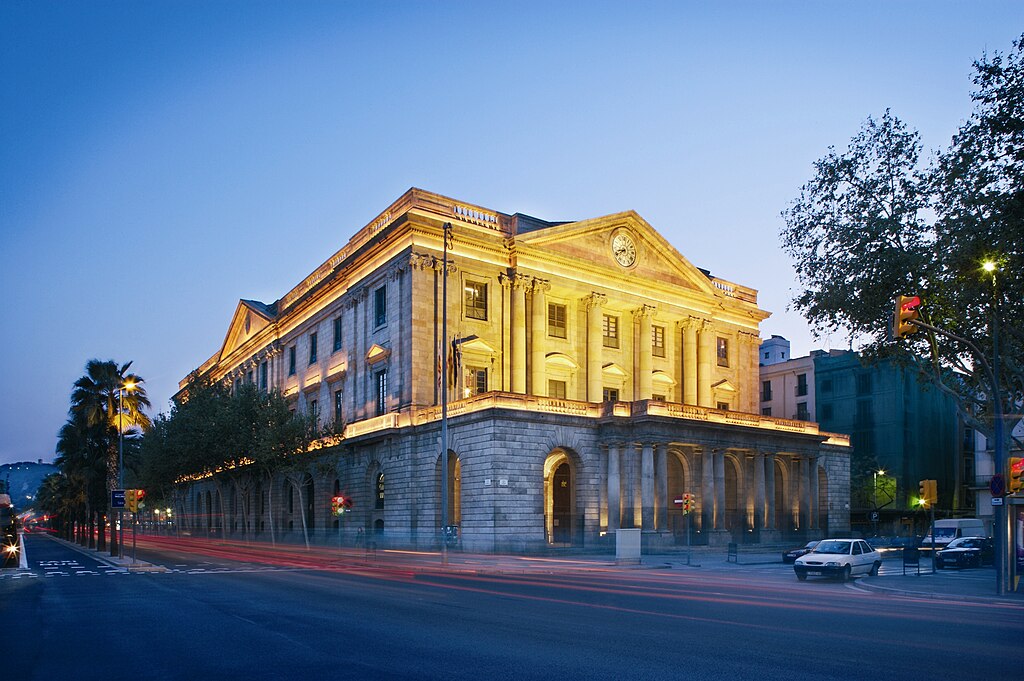
The Llotja de Mar was once an incredible example of Gothic Architecture in central Barcelona. The original building was a large hall for merchants to trade in. Eventually, in the 19th century, the Gothic structure was completely enclosed inside a newer Neoclassical Building. The new exterior of the Llotja de Mar contains all of the typical elements of Neoclassical Architecture, including Corinthian Columns, Pedmients, balustrades, and a lack of color. Today the Llotja de Mar is utilized by the Royal Catalan Academy of Fine Arts of Saint George.
12. Barcelona City Hall

Barcelona City Hall is one of the city’s greatest examples of Neoclassical Architecture. The Neoclassical Style was very popular in the 19th century and was particularly utilized in government buildings. Barcelona City Hall’s main facade embodies the rigid and formal aesthetic of the Neoclassical Style. It faces Saint James’ Square and is located directly across from the Renaissance-Styled Palau de la Generalitat de Catalunya. You can get a great view of both buildings and the rest of Saint James’ Square by checking out this Photo Sphere.
13. University of Barcelona Main Building

The Main Building of the University of Barcelona is located just outside the Gothic Quarter, not far from Plaza Catalunya. It was completed in the 1870s, and designed in the Romanesque Revival Style. Romanesque Revival replicates older works of Romanesque Architecture, by utilizing round arches, boxy forms, and simple geometric detailing. The University of Barcelona Building also has influences from the Renaissance is a great example of the Revival Movement which was flourishing in Western Europe and the Americas at this point in time.
14. Estacio del Nord
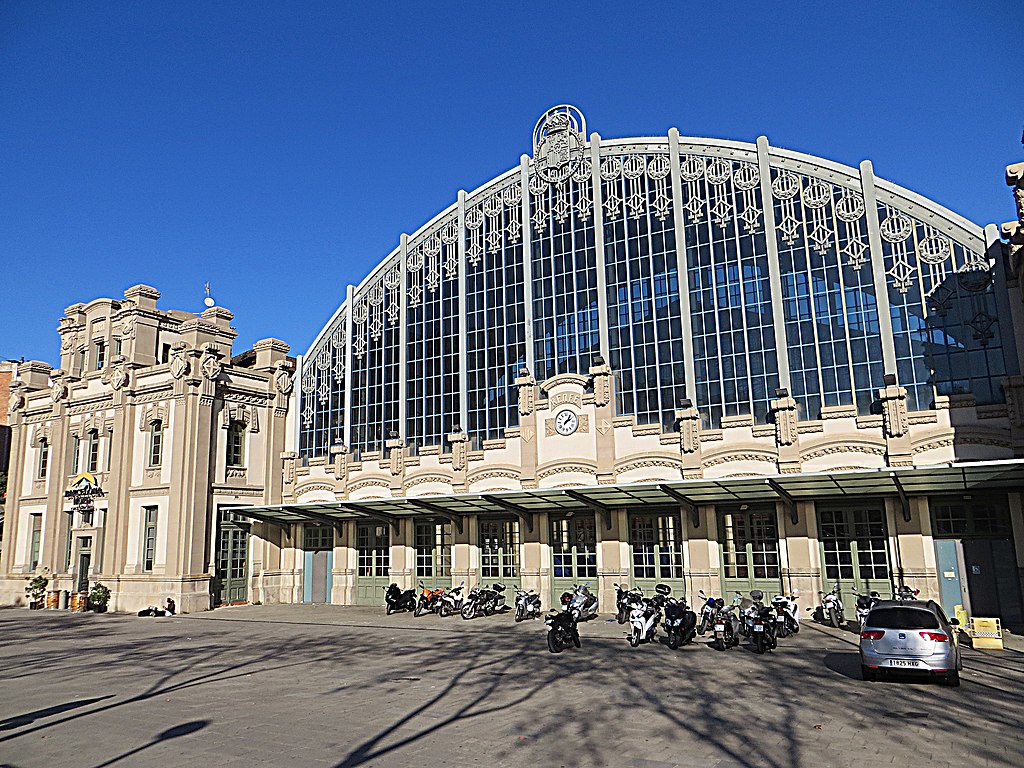
During the Industrial Revolution in the 19th century, train lines became a vital part of transportation infrastructure throughout all of Europe. The Estacio del Nord was completed in 1862 and it served as one of Barcelona’s main train stations until 1972. The station helped connect Barcelona with other nearby cities such as Madrid and Valencia, but today most train traffic goes through Barcelona-Sants Station. Today the building houses a variety of functions, including a police station, bus station, and corporate offices.
15. La Monumental
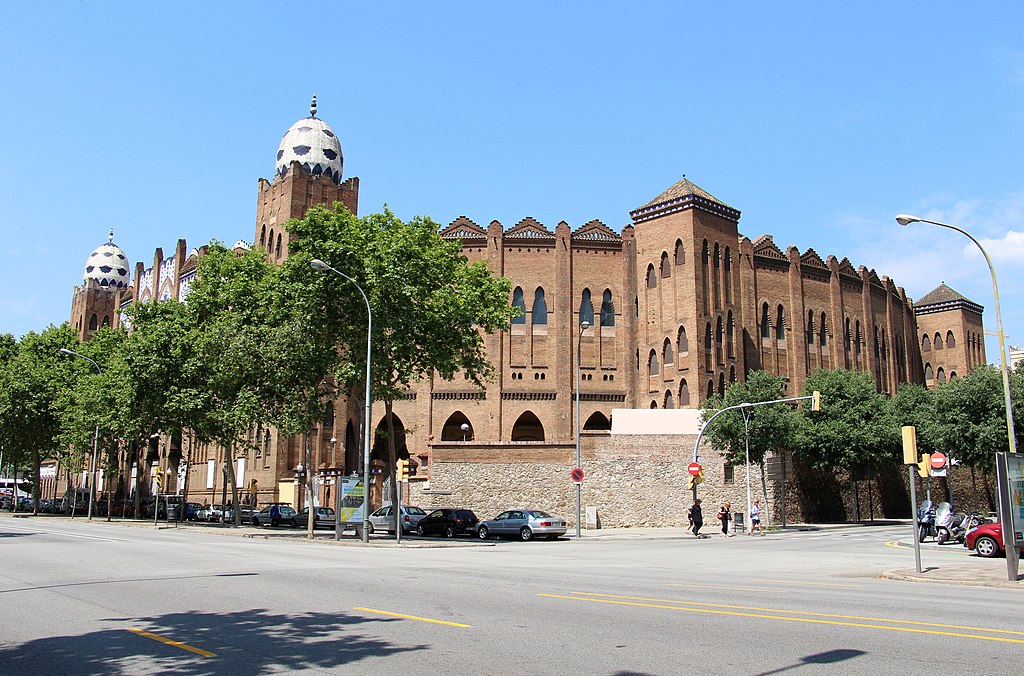
Bullfighting is very popular in Spain and it’s an important part of Spanish Culture. While many people see the sport as inhumane, many Spaniards see it as an important tradition and art form. Barcelona and many other Spanish Cities contain bullrings designed to host large bullfighting events. Barcelona’s bullring is known as “La Monumental” and it is an impressive structure that was completed in 1914. It was designed in the Mudejar Style, and it resembles many of the works of Moorish Architecture throughout Spain.
16. Gobierno Militar de Barcelona
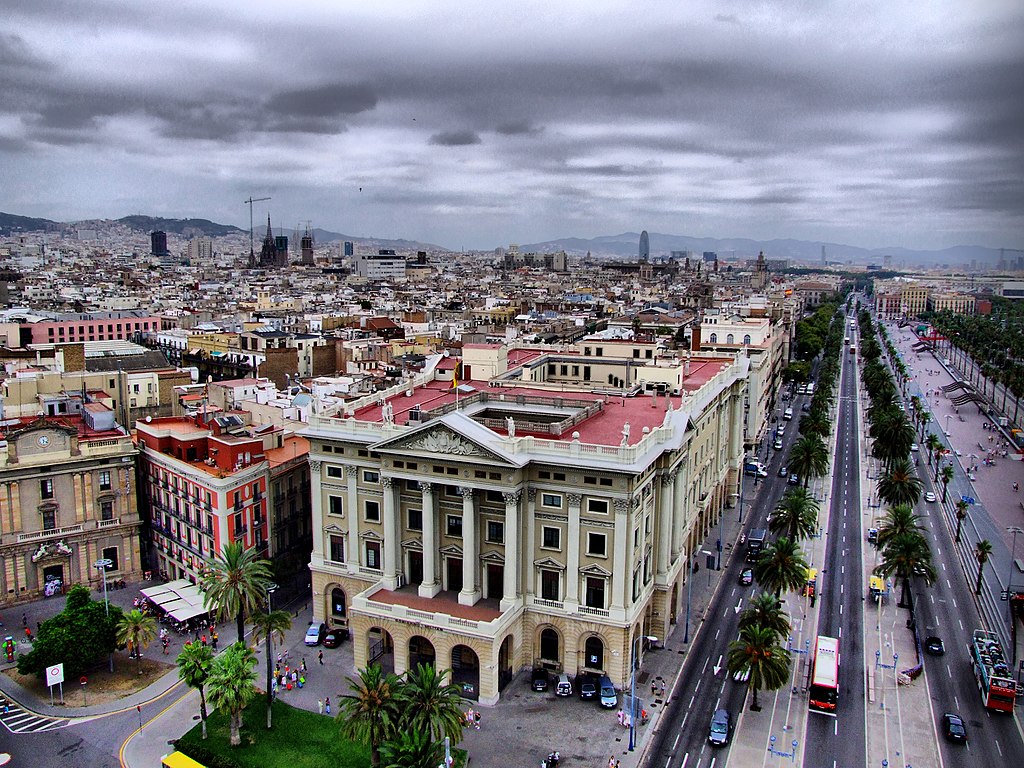
The Gobierno Militar de Barcelona is a Neoclassical building located at the ending point of La Rambla, just across from the Columbus Monument. The building was completed in the early 1900s, and houses functions related to the Spanish Military. Its symmetrical front facade showcases all of the typical elements in Neoclassical Architecture. There is a large central pediment sitting atop four Corinthian Columns, and the entire roofline is decorated with lots of Neoclassical Statues.

Interested in Revival Architecture? Check out our article on the Architecture of Stockholm to see more great examples of Revival Style Buildings.
Antoni Gaudi & Modernisme Architecture in Barcelona
Modernisme is a style unique to Barcelona and the surrounding region of Catalonia. Antoni Gaudí is one of the most notable architects of the Modernisme Movement and many regard him as the father of the entire style. Modernisme Architecture combines intricate details, a strong sense of meticulous craftsmanship, a lack of straight lines and boxy forms, and the incorporation of natural organic elements such as plants and animals. Modernisme evolved around the same time as other similar styles such as Art Nouveau, Beaux Arts, and Art Deco Architecture – but many regard Modernisme as its own style because of its unique characteristics. There are dozens of incredible examples of Modernisme Architecture in Barcelona and the surrounding area, and many people visit the region specifically to see these renowned buildings.

Map of Barcelona highlighting important works of Modernisme Architecture within the city.
1. La Sagrada Família
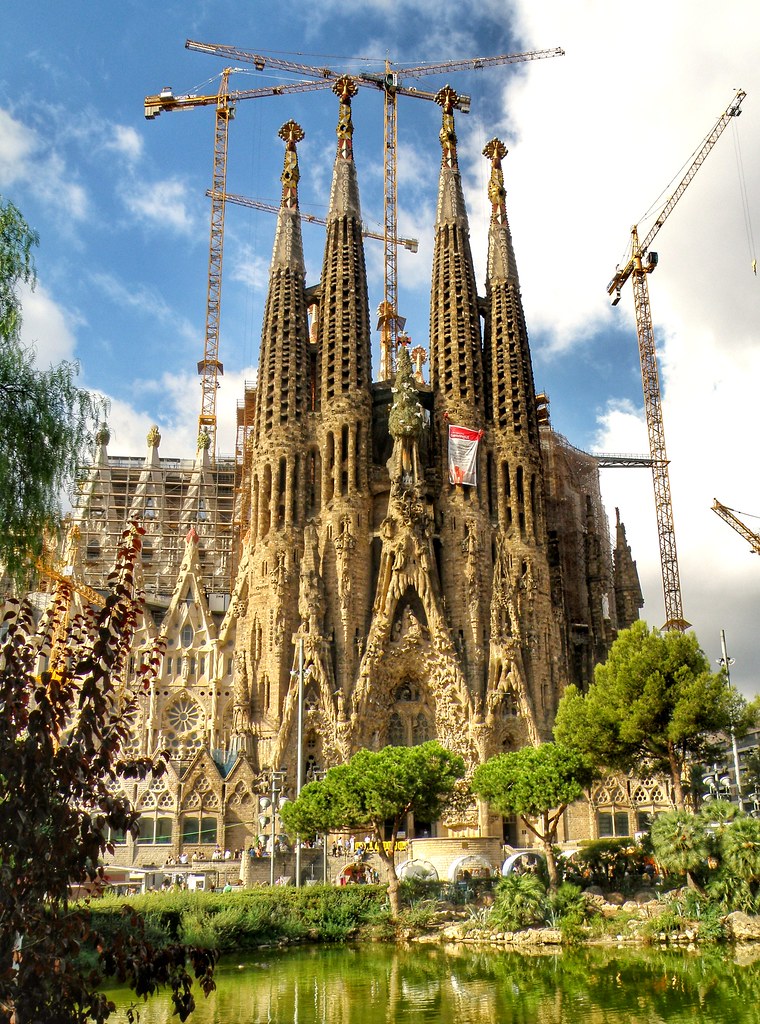
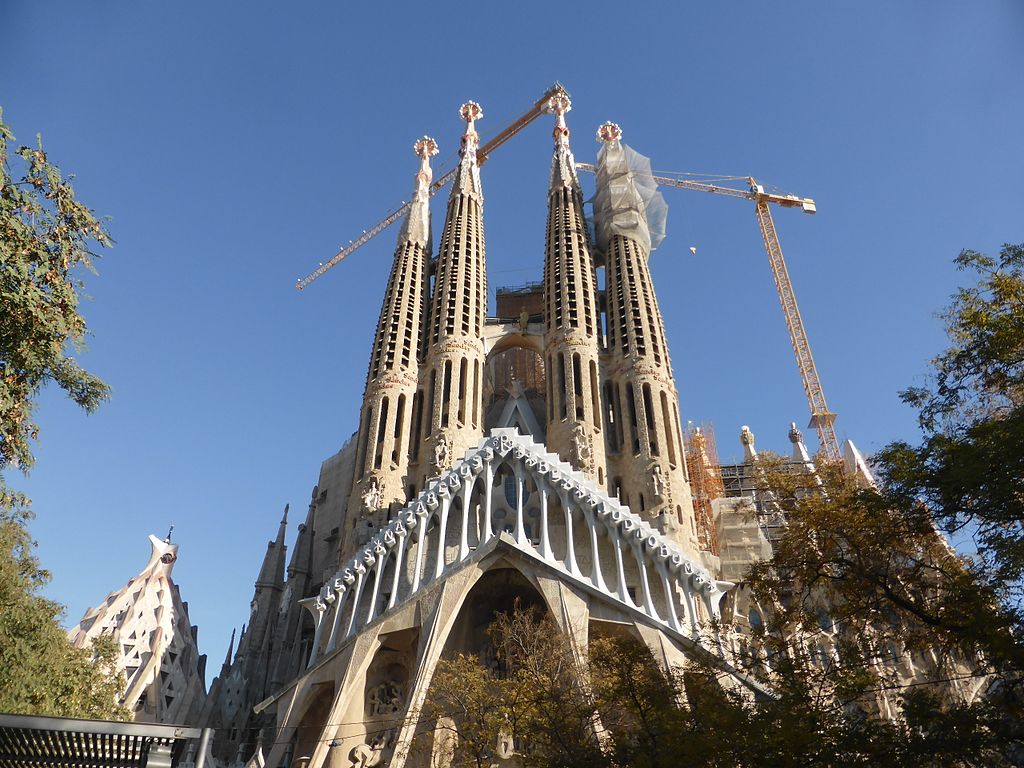
The world’s most famous example of Modernisme Architecture is the Sagrada Família. Construction began on the church in 1882, and it was one of the earliest projects of Antoni Gaudí. Currently, the church is still being worked on, and it isn’t expected to be completed until 2026. The Sagrada Família towers over the city of Barcelona, and it takes up an entire block of the Eixample Neighborhood. Antoni Gaudí’s design is incredibly innovative. The towers themselves follow the shape of a Catenary Curve, which is a form that occurs when a loop of thread is left to hang from a fixed point. Gaudí Constructed a model of the Sagrada Família during the early planning stages, and he used a combination of strings and weights to demonstrate the building’s towering forms.

Gaudí also incorporated all of the typical elements of the Modernisme Style, including natural components and lots of fluid and organic sculptural elements. The image above shows Sagrada Família’s oldest facade, which was the only portion of the building completed in Gaudí’s lifetime. Here the hard stone is sculpted into various figures, plants, and animals. This connection to nature repeats throughout the Sagrada Família and can also be found across the city of Barcelona.

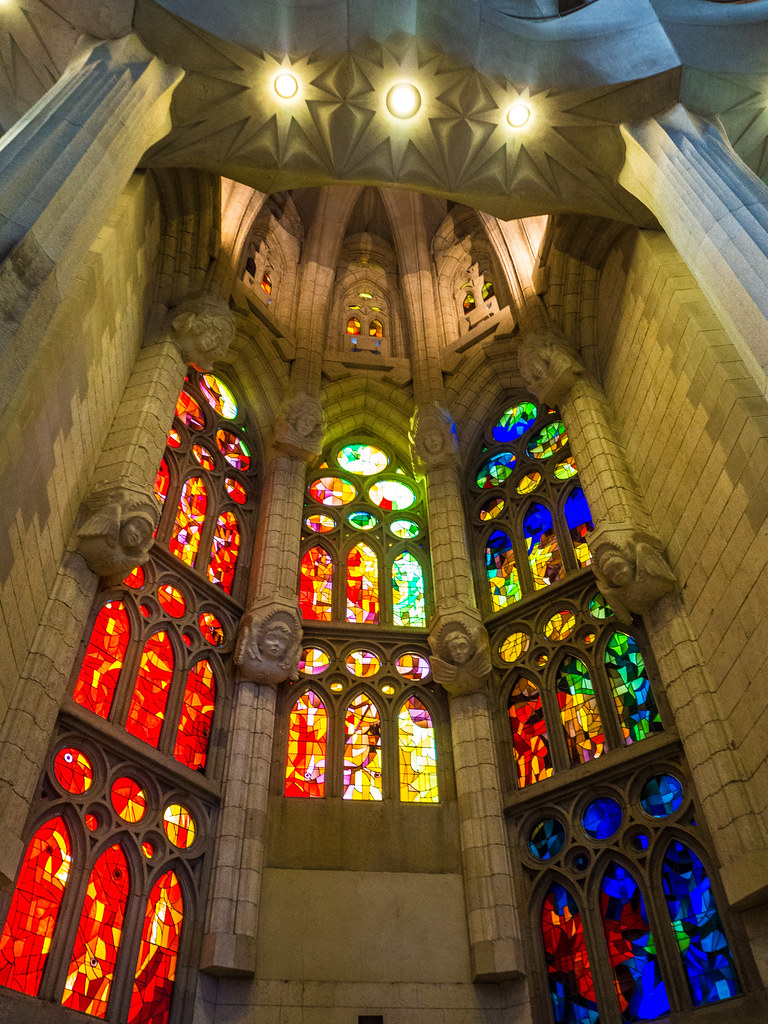
The interior of the Sagrada Família is also incredible. The church has a towering Nave lined with incredibly tall windows filled with stained glass. The bright dazzling colors of the stained glass are also important features found in the Modernisme Style. Today visitors can buy tickets to see the church’s interior, and much of the profits help fund the construction effort. The Sagrada Família is one of the world’s most well-known buildings, and it was recognized as a UNESCO World Heritage Site in 1984.
2. Park Güell
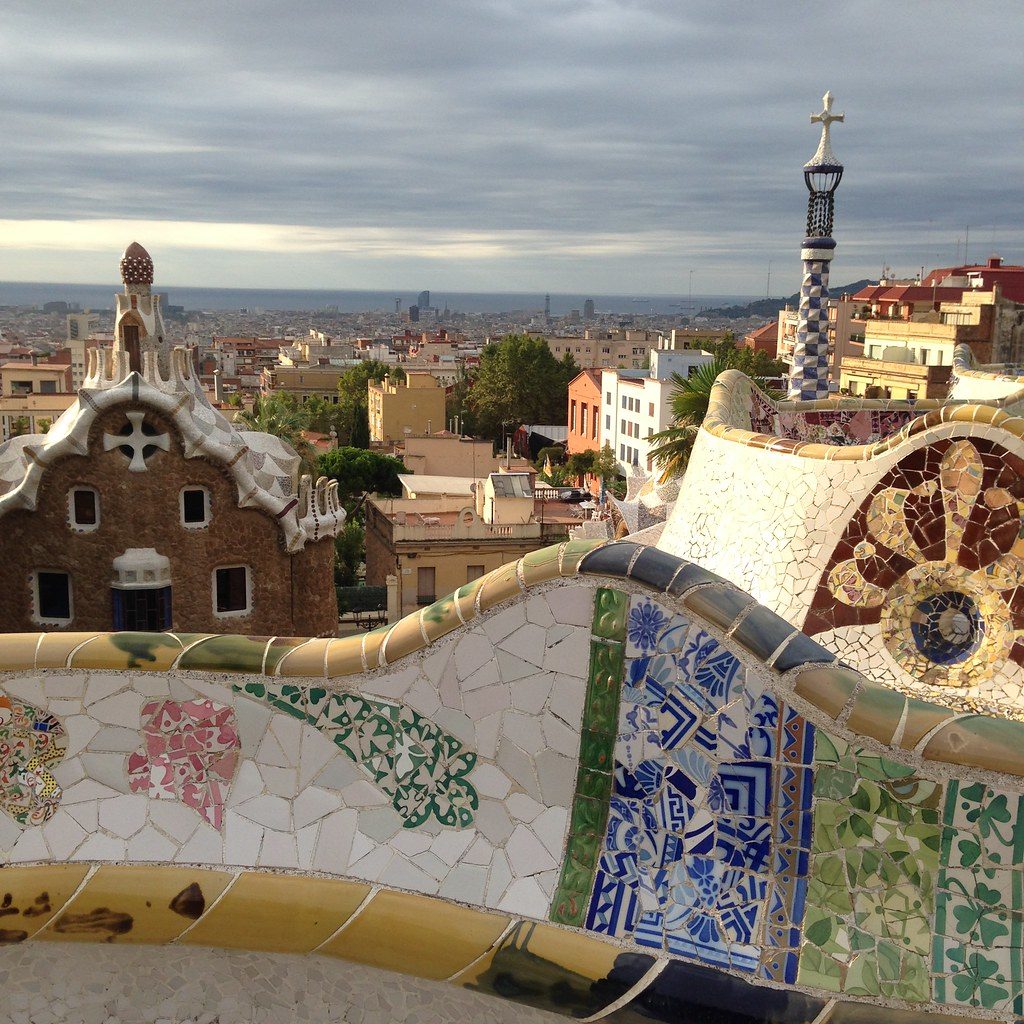
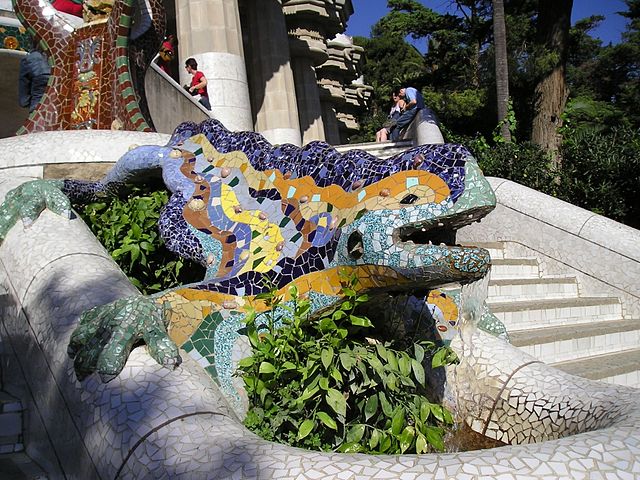
Park Güell is another incredible work of Modernsime Architecture designed by Antoni Gaudí. It’s located on the northern edge of Barcelona and features commanding views over the city and the Mediterranean Sea. The park’s focal point is a two-level pavilion with a hypostyle hall below a large lookout platform. This pavilion contains many Modernisme elements such as intricate mosaics and a strong natural influence. The right image above shows a mosaic-covered lizard, that has since become one of Barcelona’s most photographed works of art.

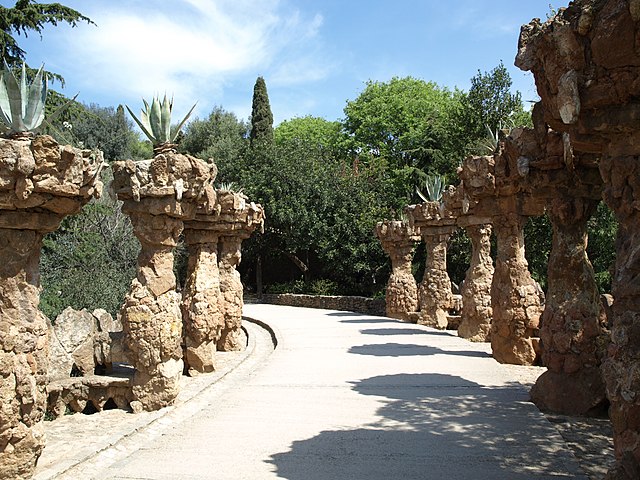
Park Güell also contains a series of elevated walkways all built from thousands of pieces of rough-cut stone. These elaborately placed stones show meticulous attention to detail – which is a key element found throughout the arts & crafts movement and the Modernisme Style. When viewing these structures you can get a sense of the time and care needed to create them, which was an important theme within lots of Antoni Gaudí’s designs.
3. Casa Batlló
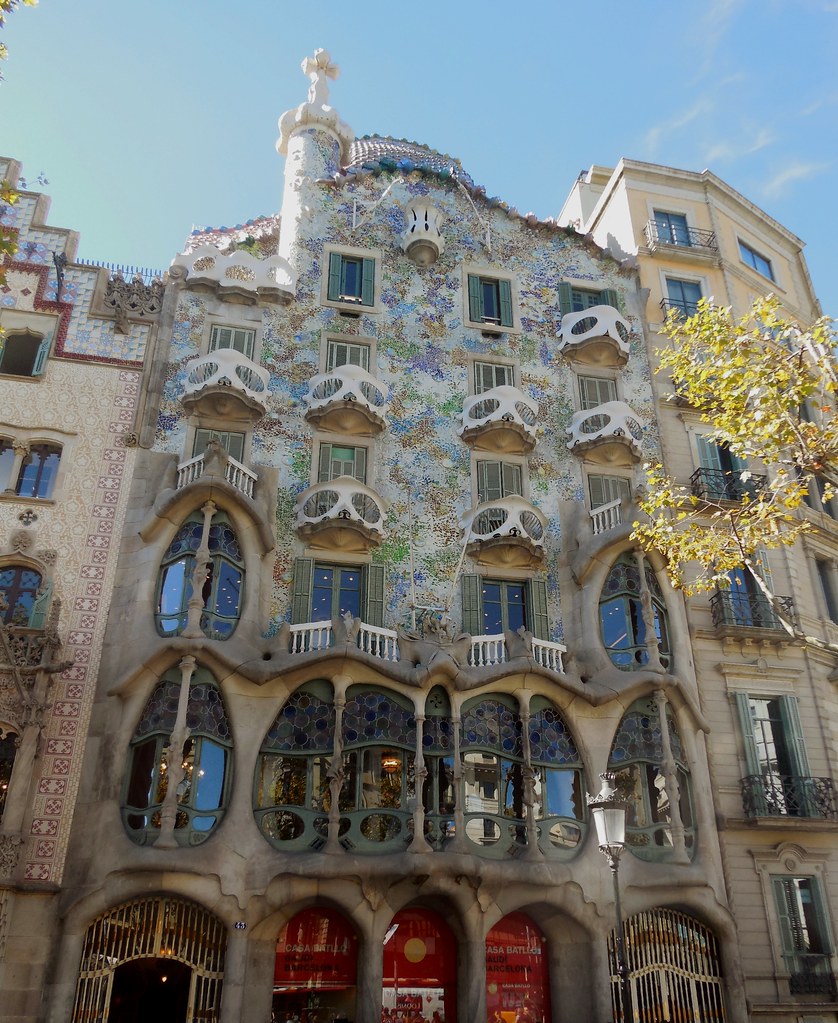
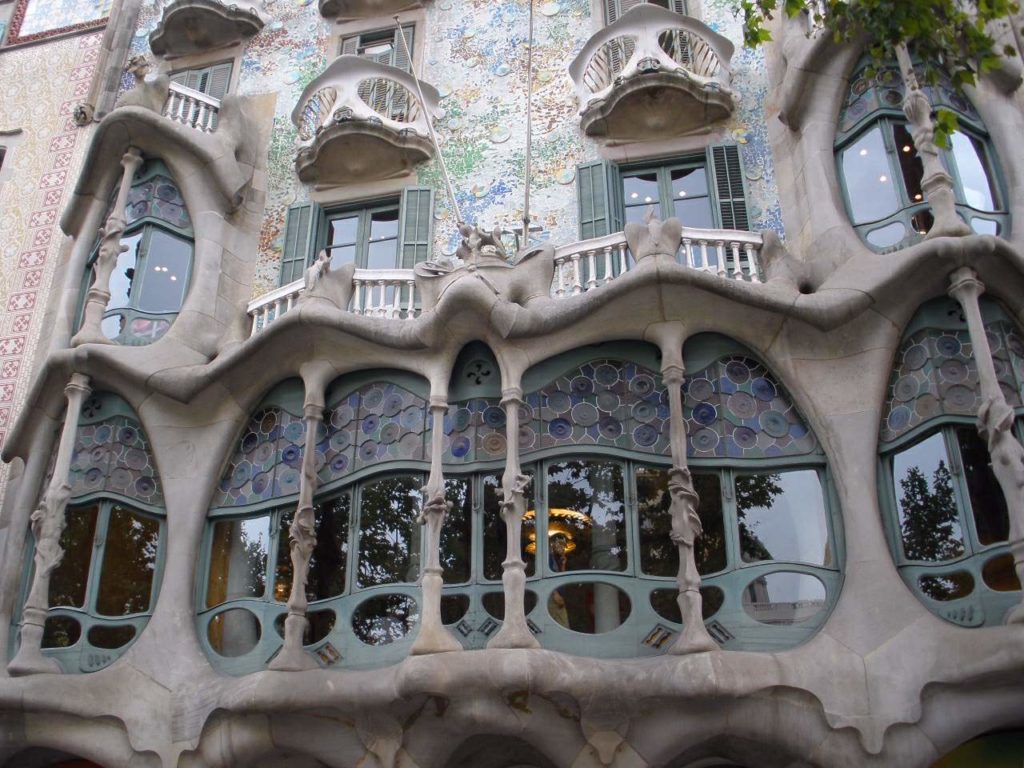
Casa Batlló is another incredible work of architecture in Barcelona designed by Antoni Gaudí. Many people refer to the Casa Batlló as the “dragon house.” This is because the roofline closely resembles the scaly backside of a dragon or reptile. This nod to nature was a key element in many of Gaudí’s designs. The rest of the facade of Casa Batlló is made up of intricately designed glazed tiles, and the railings on the balconies are also particularly striking. It’s hard to find any straight lines throughout the facade, which helps Casa Batlló stand out from many other structures in the Eixample Neighborhood.
4. Hospital de Sant Pau

The Hospital de Sant Pau is a complex of Modernisme Buildings designed by Catalonian Architect Lluís Domènech i Montaner. It is located just outside the Eixample Neighborhood, at the end of a long diagonal axis that connects with the Sagrada Família. The buildings were completed in the early 1900s, at a time when the Modernisme Movement was reaching its peak in popularity. The image above shows the main building on the campus, which combines Modernisme and Gothic Revival design elements.
5. Casa Milà

Casa Milà is another one of Gaudí’s many building projects. It’s located in the heart of the Eixample District, overlooking the famed Passeig de Gracia. Casa Milà follows the rigid guidelines of the Eixample Blocks, and it features a chamfered corner. This design was meant to open up Barcelona’s streets and bring more natural light down to the sidewalks. Just like at the nearby Casa Batlló, Casa Milà features undulating and curving stonework and a strong sense of detail and craftsmanship. The building is open to the public, and visitors can see its lush & green inner courtyard, along with its sculptural rooftop terrace.
6. Palau de la Música Catalana

The Palau de la Música Catalana is another great example of Modernisme Architecture in Barcelona. Translating to “The Palace of Catalan Music,” the building was meant to be a performing arts venue for musical acts. Both the interior and exterior are particularly striking. The exterior contains an array of intricately detailed columns. Each one is unique and they all feature mosaics and organic forms. The main theater space also contains a lot of Modernisme elements, including a massive skylight with intricate and brightly-colored stained glass.
7. The Port of Barcelona Building
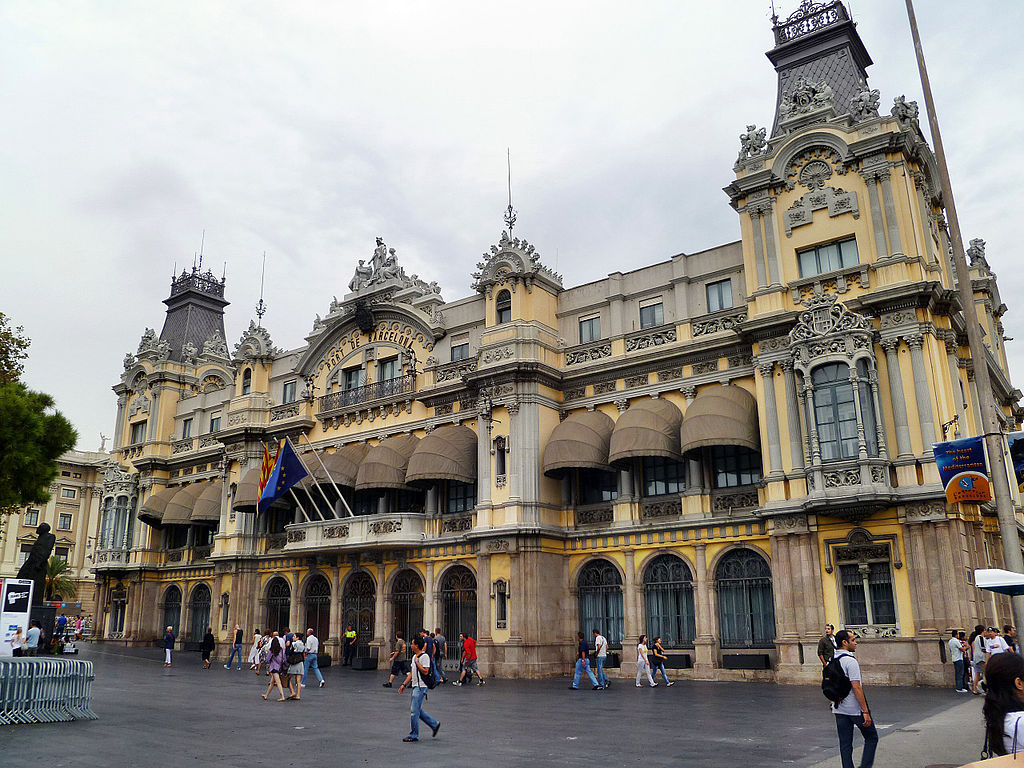
The Port of Barcelona Building was completed in 1907 and designed in the Modernisme Style. The building contains a lot of influences from the Art Nouveau Movement that was popular in Europe at this time. It originally served a variety of functions focused on the people and goods that were entering Barcelona via its port. In 2024 the building underwent a massive restoration. The top floor (which was an addition from the 1940s) was removed, and the lower floors are being brought back to their original appearance. You can learn more about the project here.
8. Palau Güell


The Güells were an extremely wealthy family that were huge patrons of Antoni Gaudí. In addition to providing funding for Park Güell, they also financed their own residence, known as Palau Güell or Güell Palace. The building is located in the heart of Barcelona, just a few steps off La Rambla. The Palau Güell shows how varied the works of Antoni Gaudí are. Although nothing like Casa Batlló or Casa Milà, you can still see some of the same motifs and design elements.
9. Casa de la Punxes
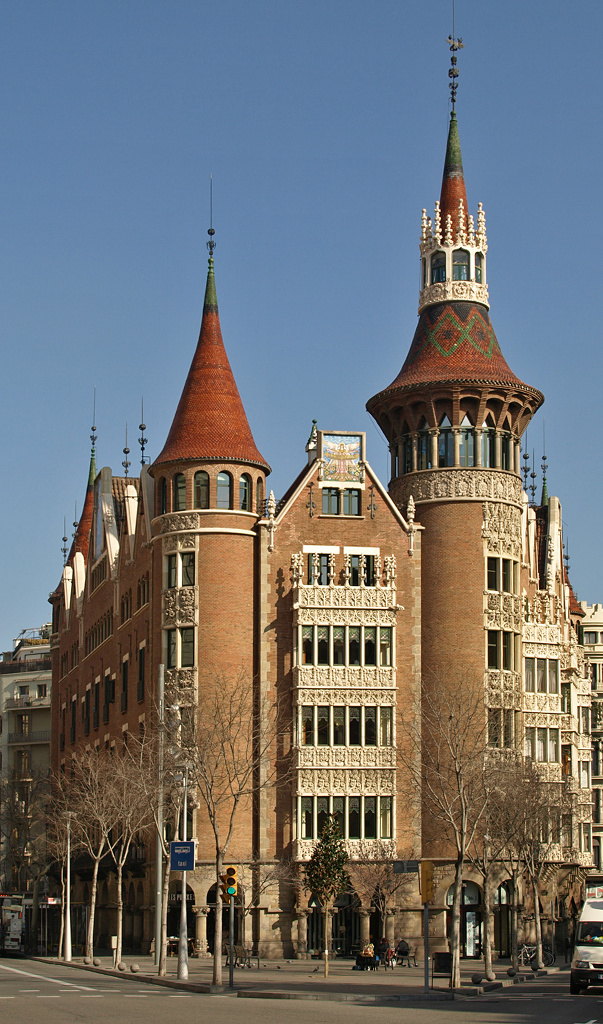
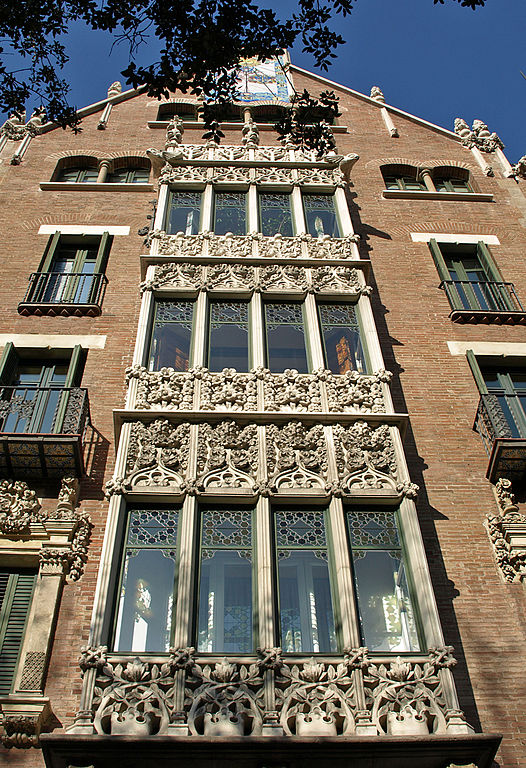
Casa de la Punxes is a Modernisme building from the early 1900s. It was designed by Josep Puig i Cadafalch, who was one of Catalonia’s most notable Modernist Architects. The house is located on the edge of the Eixample Neighborhood along the Avinguda Diagonal. The wedge-shaped floor plan of the building creates three distinct facades, each of which is outfitted with intricate stone details. Casa de la Punxes also has strong Gothic and Medieval Influences, with hints of Gothic Tracery.
10. Bellesguard

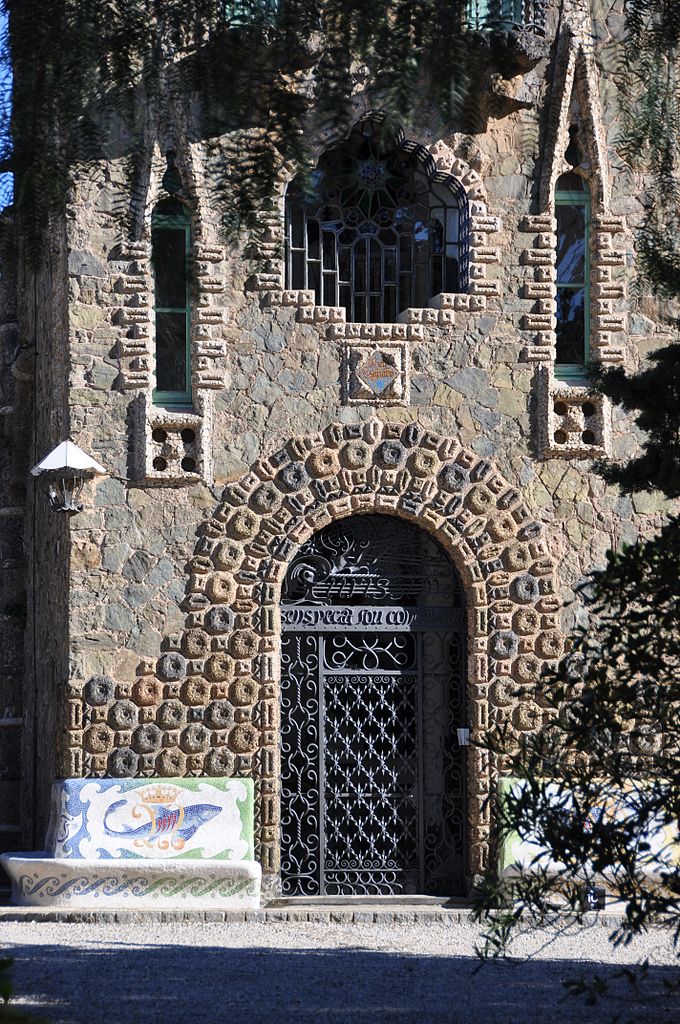
Located at the base of the mountains outside Barcelona, Bellesgard is a notable residence designed by Antoni Gaudí. It was completed in 1909, during the peak of Gaudí’s career, and it contains many of the typical elements and iconography of Modernisme Architecture. There are several references to nature, in addition to handcrafted mosaics and other details. Bellesgard also has a strong Gothic Influence, and it contains many pointed arches and spires.
11. Casa Amatller
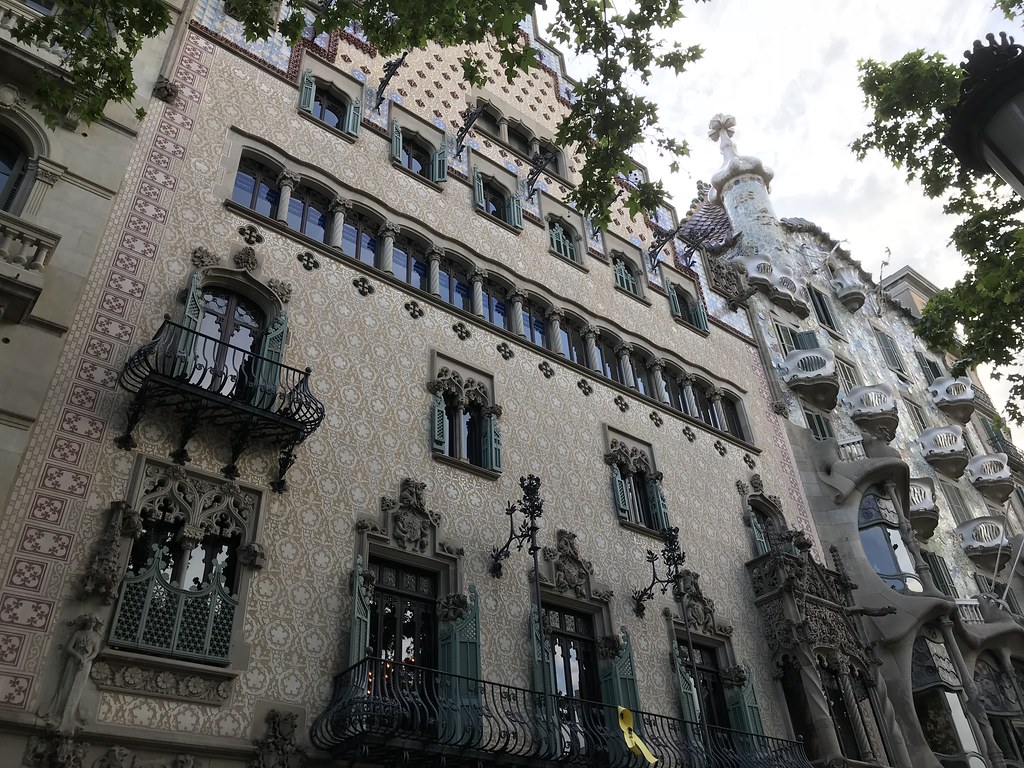
Casa Amatller is another impressive example of Modernisme Architecture in Barcelona. It shares a demising wall with Casa Batlló and it was designed by the architect Josep Puig i Cadafalch. The main facade faces the Passeig de Gràcia and was completed in 1900. Like many other Modernisme Buildings, it contains influences from Gothic and Medieval Architecture, and also possesses a strong connection with craftsmanship and nature,
12. Castle of the Three Dragons
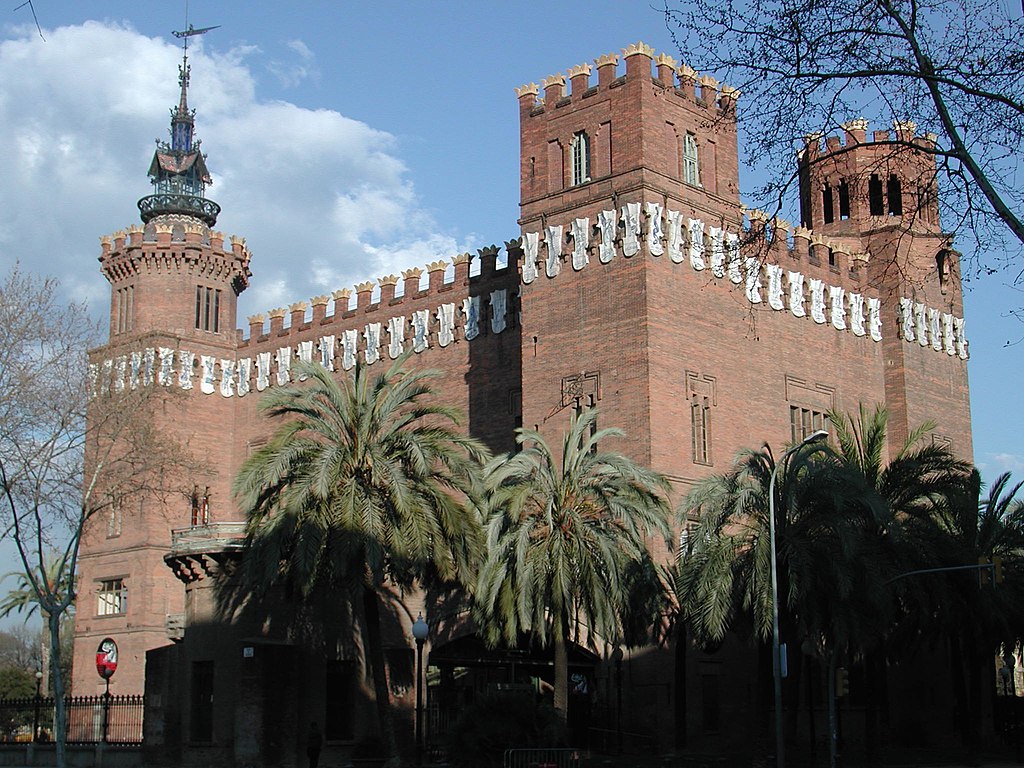
One of several notable buildings in Barcelona’s Ciutadella Park, the Castle of the Three Dragons is a Modernisme structure that was built in preparation for the 1888 Barcelona Universal Exposition. It was designed by one of Catalonia’s great Modernist Architects, Lluís Domènech i Montaner. The Castle of the Three Dragons is located at the end of the Passeig de Lluís Companys, which connects with other notable landmarks such as the Arc de Triomf.
13. Casa Fuster
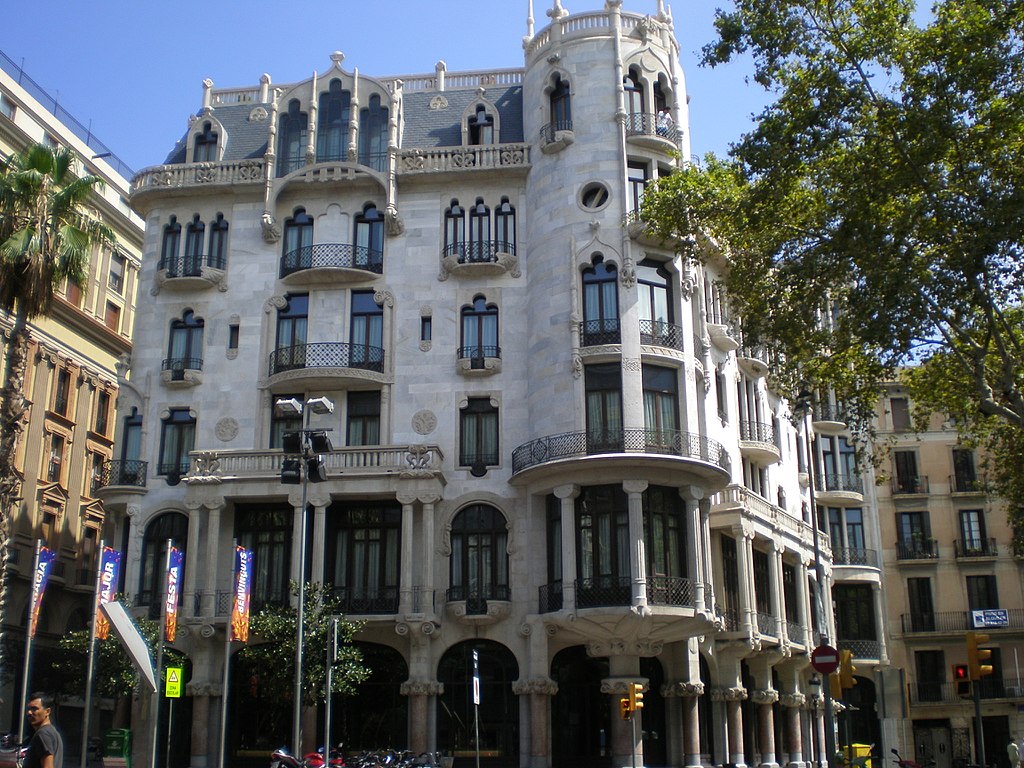
Casa Fuster is an impressive work of Modernisme Architecture built as a home for a wealthy Catalonian businessman. It was completed in 1908, and at the time was one of the grandest and most expensive residences in all of Barcelona. In the year 2000, the building was bought and refurbished into a hotel, which still occupies Casa Fuster today. Although the hotel made significant changes to the interior, the exterior facades of Casa Fuster maintain their original Modernisme Character.
14. Casa Vicens
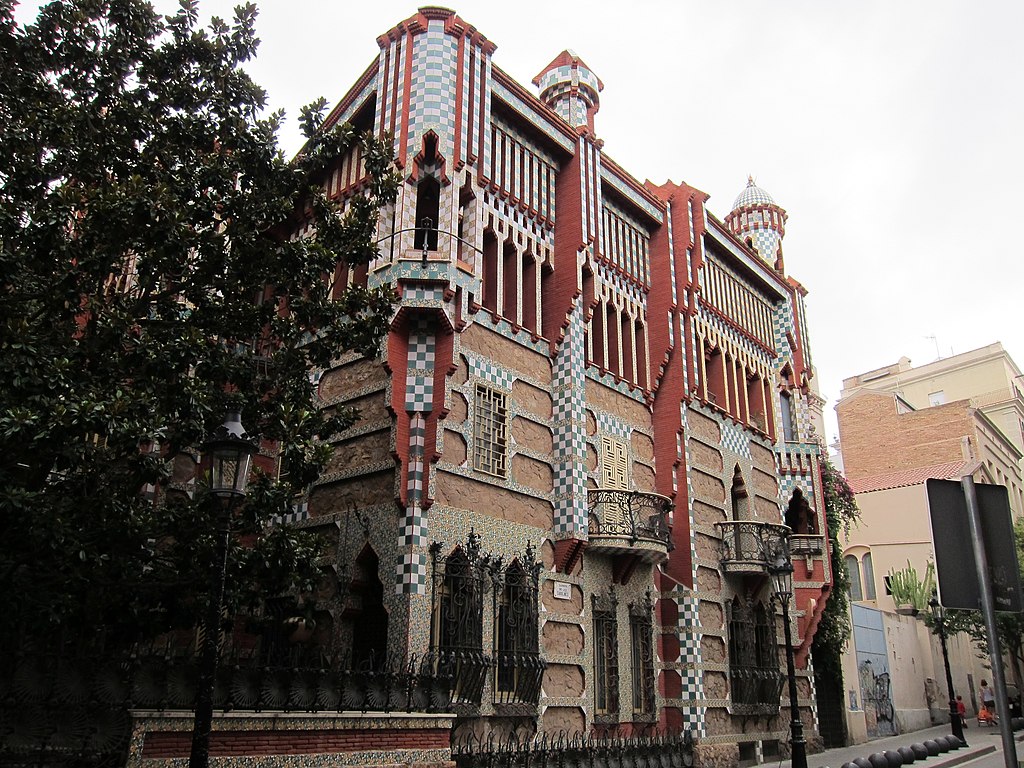
Casa Vicens is one of the earliest examples of Modernisme Architecture in Barcelona. It was one of the first buildings in the lengthy career of Antoni Gaudí, and it sparked many additional commissions for the young architect. Casa Vicens was completed in 1885, and its bright colors and intricate tilework set it apart from many of the more traditional buildings that were being built across Europe in the late 19th century. This break from traditionalism was an important element in both Modernisme, and similar design movements like Beaux Arts, Art Deco, and Art Nouveau.
15. Casa Lleo Morera
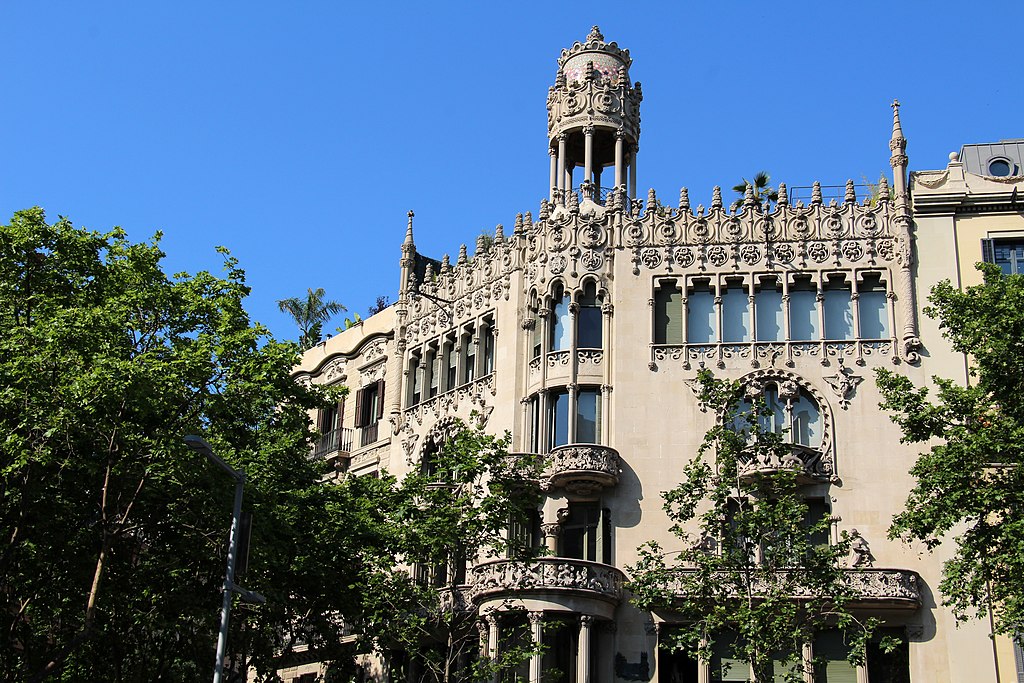
Casa Lleo Morera is another work of Modernisme Architecture located in Barcelona’s Eixample Neighborhood. It was designed by renowned architect Lluís Domènech i Montaner. The house was built in the early 1900s and it contains many of the typical elements of the Modernisme Style. It also has strong influences from Gothic and Moorish Architecture, two styles popular in the rest of Spain.
16. Various Modernisme Facades

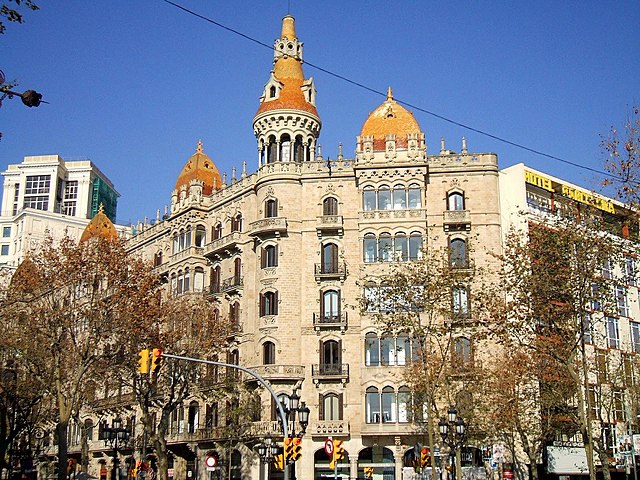
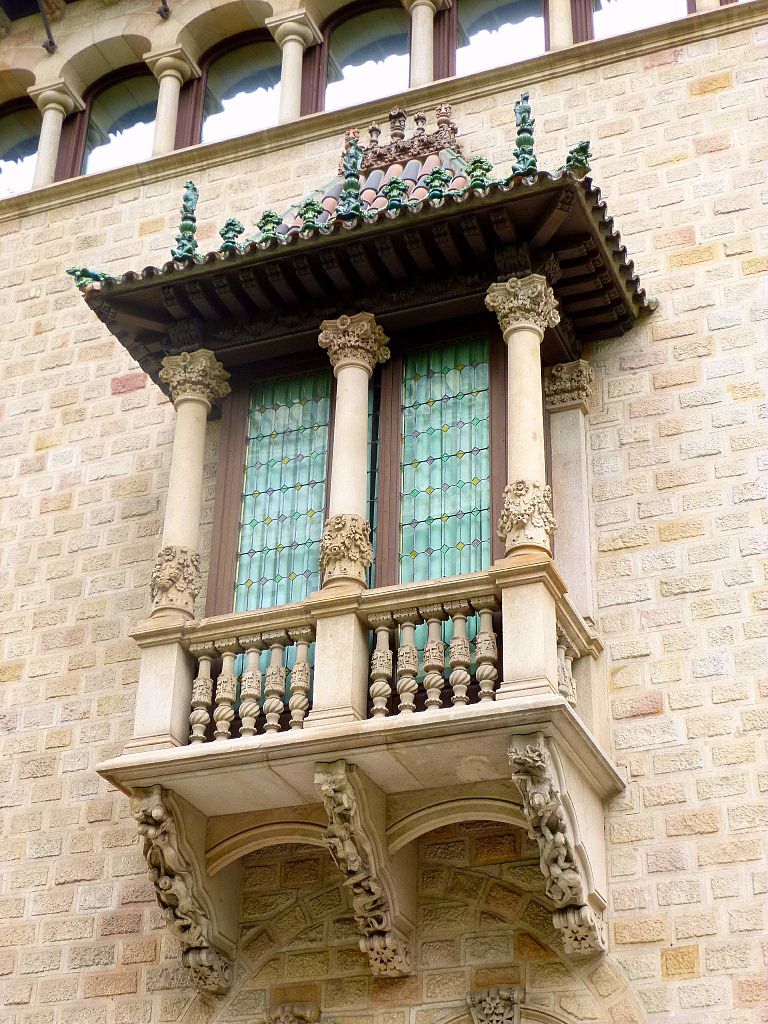
Barcelona’s Eixample Neighborhood is filled with countless examples of Modernisme Architecture. In addition to the buildings already noted above there are dozens of other facades, which embody the fluid and natural designs of the Modernisme Period. The left image above shows Casa Comalat, which is located on the northern edges of the Eixample Neighborhood. The center image shows Cases Rocamora, which is located at the start of Passeig de Gracia. The right image shows Casa Serra, which is located not far from Casa Milà.
Like Architecture of Cities? Sign up for our mailing list to get updates on our latest articles and other information related to Architectural History.
Modern Architecture in Barcelona
Barcelona is also home to a large assortment of modern architecture. Lots of Barcelona’s contemporary buildings are located on the outer edges of town, outside the popular neighborhoods of the Eixample and the Gothic Quarter. Barcelona hosted the 1992 Summer Olympics, at which point the city’s infrastructure and waterfront neighborhoods were completely revamped. Although varied, many of Barcelona’s modern buildings contain hints from the city’s past, and there are occasional references to both Catalan Gothic & Modernisme Architecture.

Map of Barcelona highlighting various works of Modern Architecture within the city.
1. Barcelona Pavilion


The Barcelona Pavilion is an example of modern architecture designed by Ludwig Mies van der Rohe. He was a renowned architect who worked throughout the 20th century and completed projects in Europe and North America. Mies was a pioneer of new building techniques and concepts. Here at the Barcelona Pavilion, he uses a combination of materials including steel, glass, and natural stone. The mirrored-marble slabs that decorate the building’s interior are particularly impressive, and they look like works of art on their own thanks to their incredible natural beauty.

The Barcelona Pavillion was constructed as Germany’s Pavillion for the 1929 Barcelona International Exhibition. The pavilion received great reviews, and although it was designed to be temporary – it still impresses visitors to this day. The Barcelona Pavillion is located along a lengthy promenade stretching from Plaça d’Espanya to the Palau Nacional de Montjuïc. The Barcelona Pavillion would help popularize Ludwig Mies Van der Rohe, which helped him get commissions after he emigrated to the United States in 1939. Today, many notable buildings designed by Mies can be found in cities like Chicago & New York.
2. Santa Caterina Market

The Santa Caterina Market is a great example of the covered market halls found throughout Barcelona and the rest of Spain. Santa Caterina originated in the mid-19th century, but the market was completely transformed during a major renovation in 2005. In addition to restoring the market’s interior, the project also added a large undulating canopy decorated with bright geometric tiles. This new addition embodies many of the key elements found throughout the architecture of Barcelona, including the use of bright colors and a strong sense of craftsmanship.
3. Torre Glòries

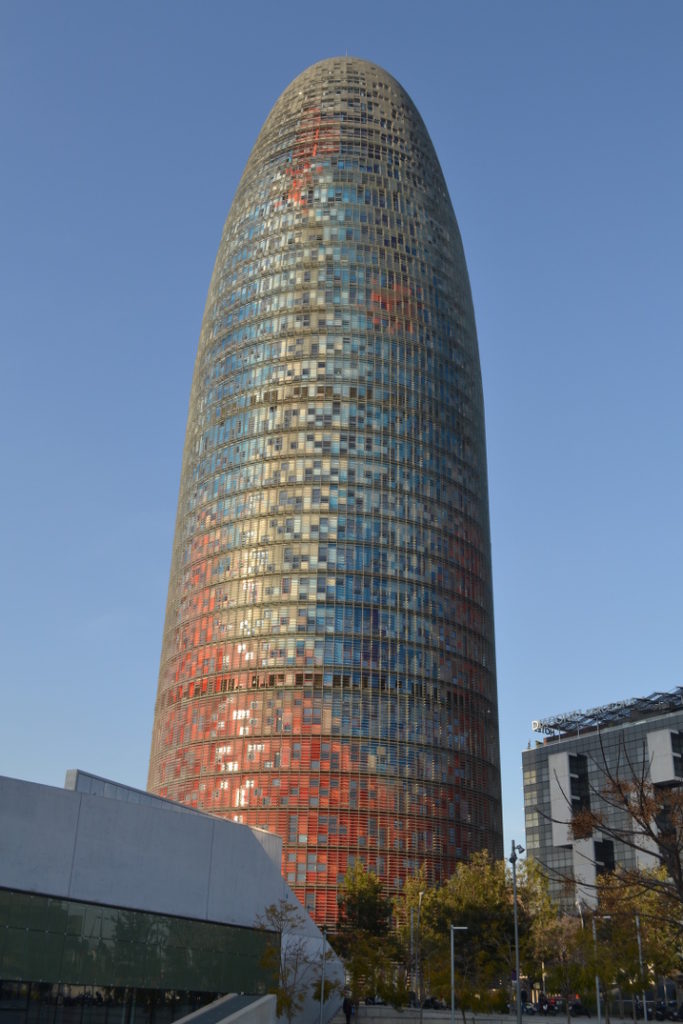
The Torre Glòries is one of the greatest examples of modern architecture in Barcelona. It was completed in 2004 and has been an icon on the city skyline ever since. The design is unique and greatly resembles the distinct Catenary Curves found at the Sagrada Família. The exterior is a mix of opaque cladding and glass, and the facade features an elaborate array of adjustable louvers that help mitigate excess sunlight and solar heat gain. The exterior cladding also features a complex color scheme of blues and oranges, also nodding at the intricate craftsmanship and detailing found in other works of Modernisme Architecture throughout Barcelona.
4. Port Olympic

The Port Olympic is a large cluster of buildings and monuments constructed as the Olympic Village for the 1992 Summer Olympics. The complex features two towers that housed athletes for the duration of the games. Afterward, the buildings were converted into a beachfront hotel and offices. At the base of the towers, there is a series of commercial spaces housing many restaurants and retailers. The complex also features a large sculpture designed by acclaimed modern architect, Frank Gehry. Gehry’s “Fish” sculpture is a popular monument, and it is a symbol of the entire Port Olympic area.
5. Barcelona Museum of Contemporary Art
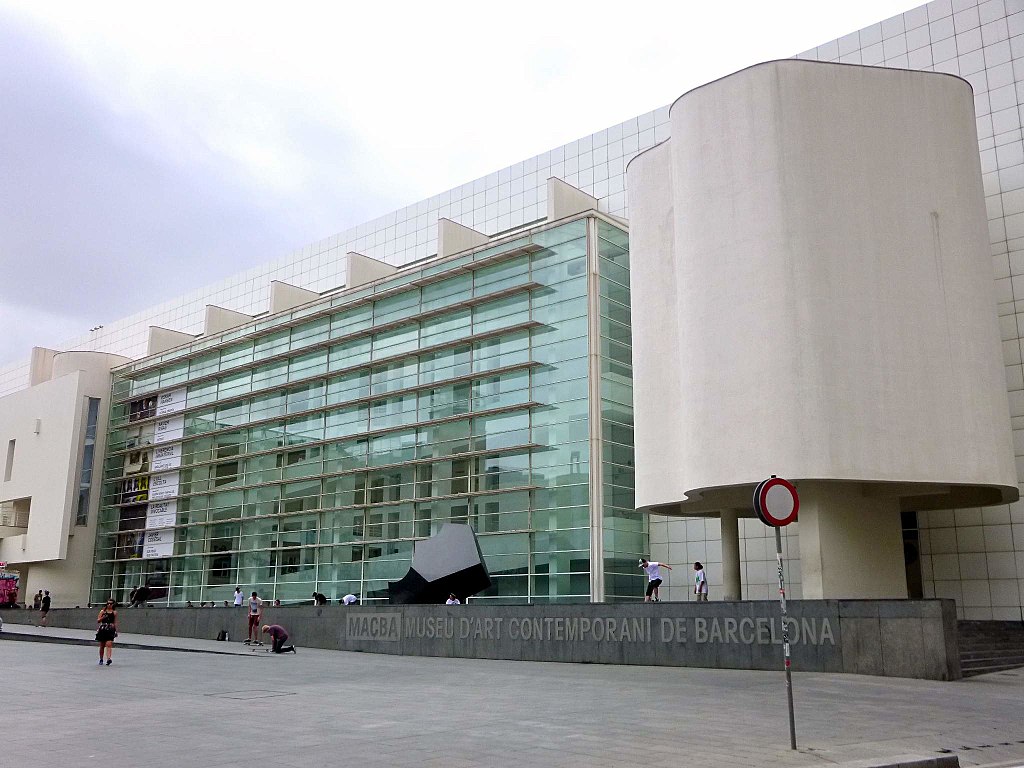
The Barcelona Museum of Contemporary Art is located in the heart of Barcelona, a short walk from La Rambla. It is one of only a handful of modern structures located within the city’s El Raval Neighborhood. Its glass and metal panel exterior greatly contrast the stone structures in the surrounding area. The museum first opened in 1995 and it features rotating exhibits focusing on modern art.
6. Arenas de Barcelona

The Arenas de Barcelona is a modern shopping mall located near the Palau de Montjuïc. The mall opened in 2011 and is home to many retailers and restaurants. The Arenas de Barcelona was constructed inside an older bullring that was originally built in 1900. The bullring was constructed in the Moorish Revival Style and features many distinct Moorish design elements. The horseshoe arches with red & white stones are particularly striking and resemble those found within the Great Mosque of Cordoba.
7. Olympic Park
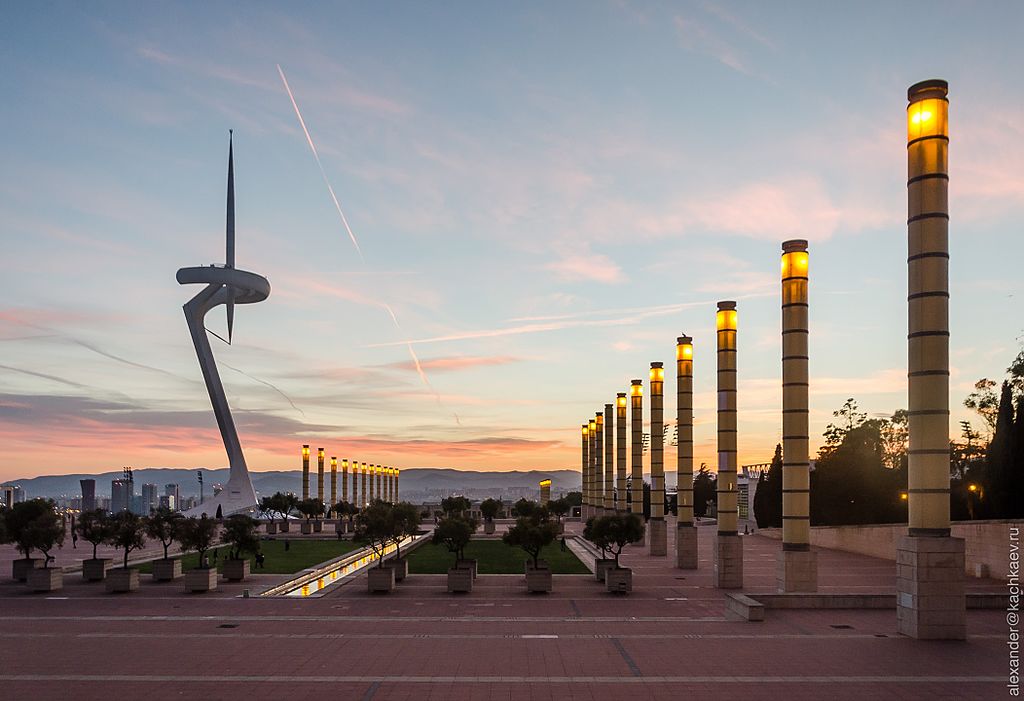
In addition to an Olympic village and a series of improvements to the city’s infrastructure, many sporting venues had to be constructed for the 1992 Olympic Games. Most of these are concentrated in an area southwest of Barcelona’s historic center. These stadiums and the monuments surrounding them served their purpose, but like a lot of Olympic stadiums, the city is attempting to maintain them and make sure they stay useful for the public. Today many private sporting events and practices are held here and the area is popular with joggers, bikers, and other fitness enthusiasts.
8. Rambla del Mar

The Rambla Del Mar was designed as a sort of extension of the original Rambla. It’s essentially a floating pier that connects the edge of La Rambla with the rest of the port. La Rambla Del Mar also contains seating areas and sculptures which make it a popular hangout spot. The Rambla Del Mar connects with a major shopping mall known as the Maremagnum.
9. W Hotel

The W Hotel is a massive newly constructed tower overlooking the Mediterranean Sea. It was completed in 2009 and features a swooping curved design resembling the sail of a ship. The entire facade is made from curtain wall, infilled with reflective blue glass. This glass reflects light, and it helps the massive building almost disappear against the blue background of the ocean and sky. Although it’s located far from the action in central Barcelona, the W Hotel is still a great place to stay for anyone who wants great views of Barcelona and the sea.
10. National Theater of Catalonia

The National Theater of Catalonia is a work of contemporary architecture in Barcelona. It was completed in 1996, and it is an interesting design meant to mimic a Classical Greek Temple. The building’s interior is completely enclosed in glass and is also lined with Doric-style columns along the exterior. The theater was built to create an auditorium specifically for plays and performances in the Catalan Language.
11. College of Architects of Catalonia Building
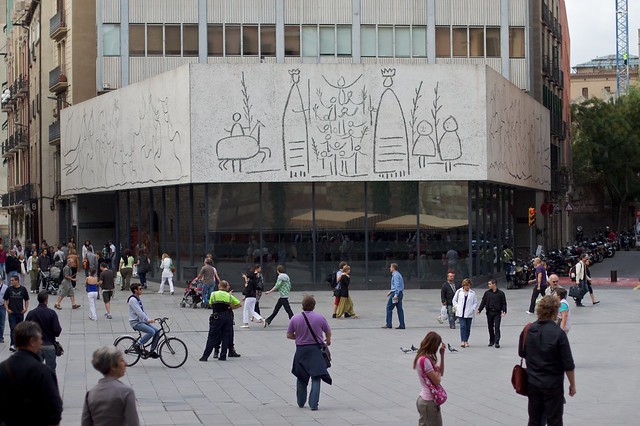
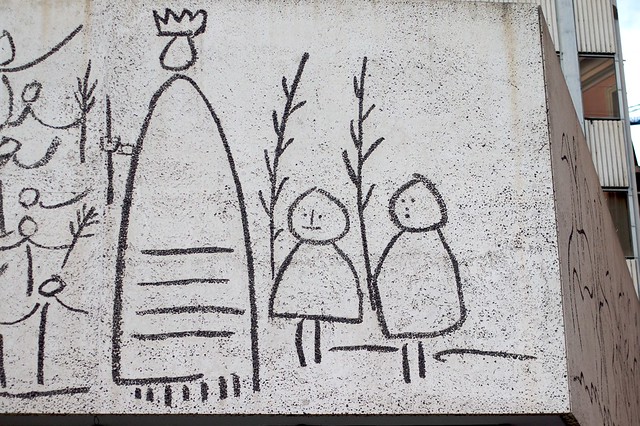
The main building of the College of the Architects of Catalonia is an impressive work of 20th-century architecture. It’s located in the same square that contains Barcelona Cathedral. The images above show the building’s main facade, which is decorated with sketches by the Spanish artist, Pablo Picasso. Picasso spent part of his childhood living in Barcelona and always had a strong connection with the city. Barcelona’s Gothic Quarter is also home to the Museu Picasso, which houses a collection of the artist’s early works.
12. Design Museum of Barcelona

The Design Museum is another great work of contemporary architecture in Barcelona. The museum opened in 2014, and it is just a portion of the planned development of the Barcelona Technology & Innovation District. City officials have been working toward revamping the area around the El Poblenou neighborhood, turning it into a hub for business, trade, and technology. This district is also home to other works of Modern Architecture, like the Torre Glòries and the Mercat dels Encants.
Neighborhoods of Barcelona

Map of Barcelona Showing the extent of various neighborhoods within the city
.

1. Gothic Quarter (Gótico)
The Gothic Quarter is the historic core of Barcelona. It corresponds with the area once enclosed by the city’s Medieval Walls. This part of the city is more touristy and contains a jumble of narrow winding streets and historic buildings. The Gothic Quarter contains many of Barcelona’s oldest works of architecture such as Barcelona Cathedral.
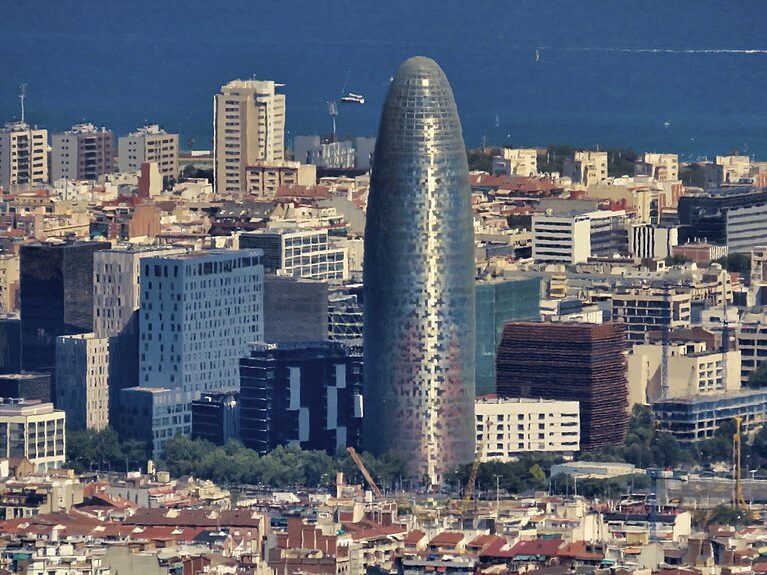
2. El Poblenou
El Poblenou is a large neighborhood located to the east of Barcelona’s Gothic Quarter. It’s a very mixed-use neighborhood with lots of residences, offices, commercial businesses, and industrial buildings. Because this neighborhood was built later on, it contains some of Barcelona’s greatest works of modern architecture.
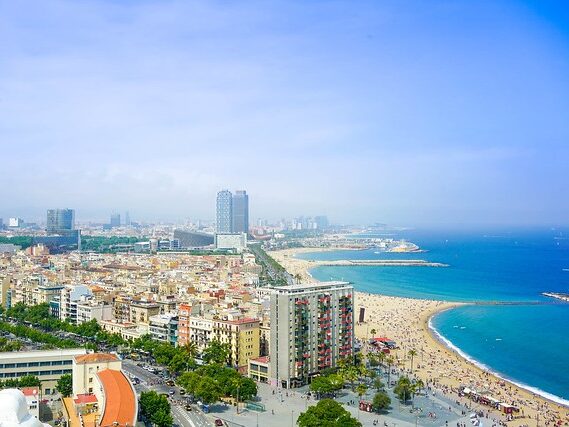
3. Barceloneta
Barceloneta is a neighborhood located on a triangular strip of land. It’s a pretty residential neighborhood but also contains plenty of bars and restaurants. Barceloneta’s biggest draw is its beaches, which bring crowds of people looking to enjoy Barcelona’s warm weather.

4. Eixample
The Eixample District is the gridded series of streets just north of Barcelona’s Medieval Core. It’s famous for its iconic urban planning with square city blocks with chamfered corners. Many of Barcelona’s most iconic buildings are located in the Eixample District such as the Sagrada Família, Casa Milà, and Casa Batlló.

5. Montjuïc
Montjuïc is the area centered around Montjuïc Hill. It was heavily developed in the early 1900s, in preparation for the 1929 Barcelona International Exposition. Today the area contains many important works of architecture such as Montjuïc Fortress and the Palau de Montjuïc.

6. Gracia
Gracia is a neighborhood on the northern edge of Barcelona. It’s located north of the Eixample District, and it’s very residential. Gracia is connected to the rest of the city by a large main road: The Passeig de Gracia. The most notable work of architecture in the Gracia Neighborhood is Park Güell, which is easily accessible by bus from the city center.
Architecture of Barcelona: In Review
Even if it only contained the incredible buildings of Antoni Gaudí and the Modernisme Movement, Barcelona would be one of the world’s top architectural destinations. But, Barcelona is about so much more. Within Barcelona, you have Roman monuments, Gothic Churches, the Eixample district, and all the modern improvements created for the ‘92 Olympics. This abundance of incredible buildings makes Barcelona one of the world’s greatest cities for Architectural History and any fan of good food, iconic architecture, and warm weather is sure to enjoy this incredible city.

- About the Author
- Rob Carney, the founder and lead writer for Architecture of Cities has been studying the history of architecture for over 15 years.
- He is an avid traveler and photographer, and he is passionate about buildings and building history.
- Rob has a B.S. and a Master’s degree in Architecture and has worked as an architect and engineer in the Boston area for 10 years.
Like Architecture of Cities? Sign up for our mailing list to get updates on our latest articles and other information related to Architectural History.


